Question
Content, Time, Place, and Manner This week, we make our turn into case law, starting with two important Supreme Court opinions from the 1980s. In

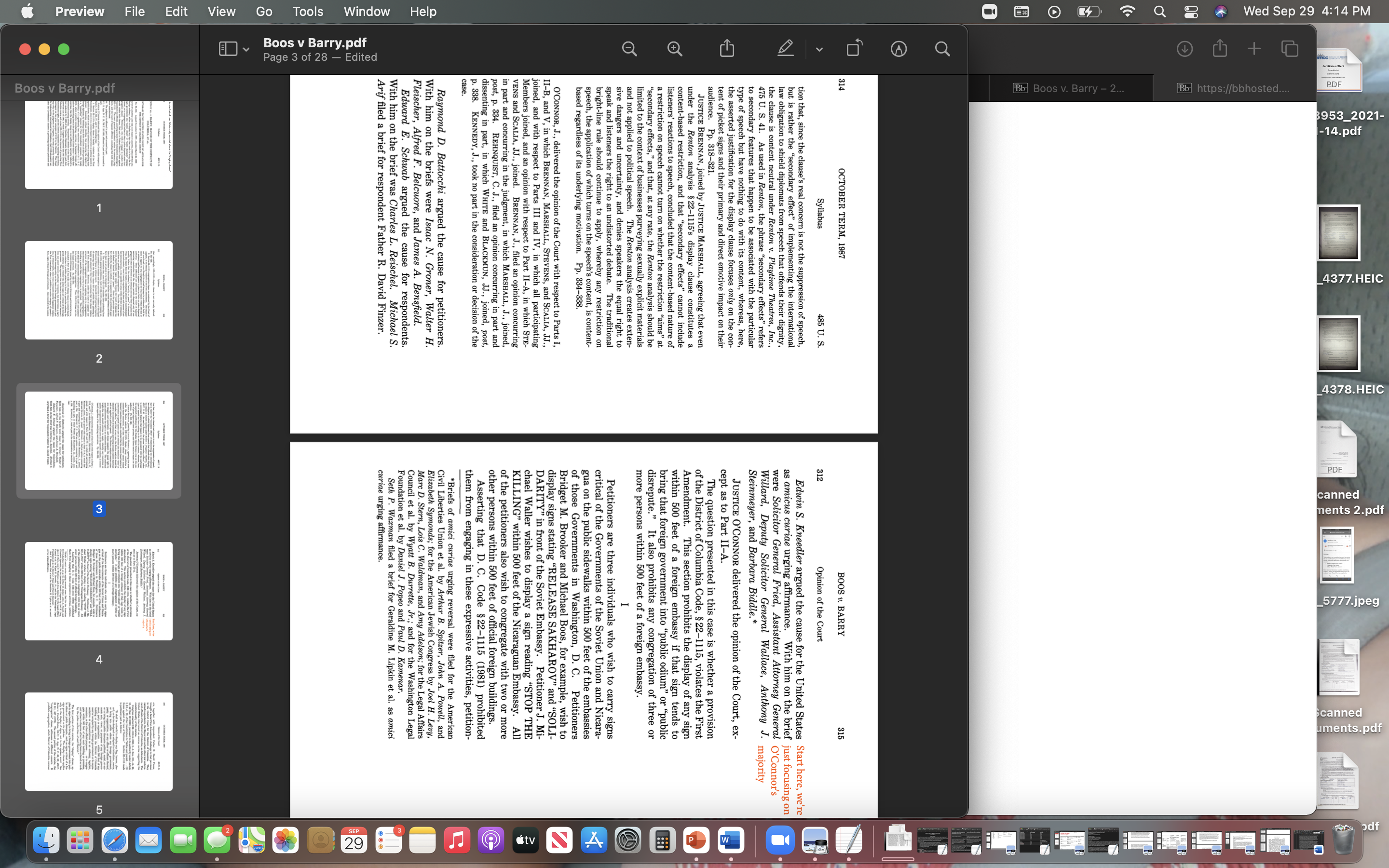
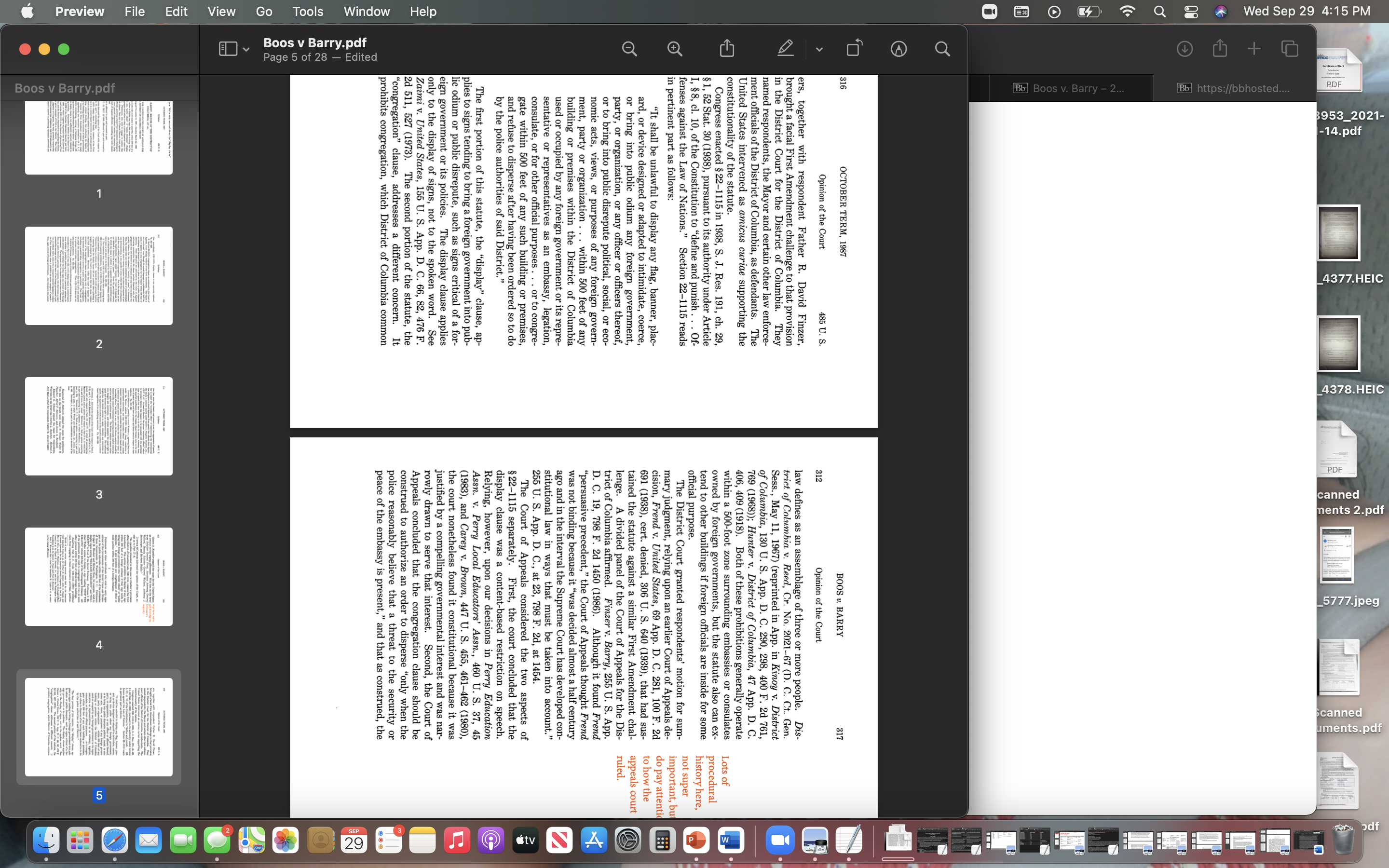

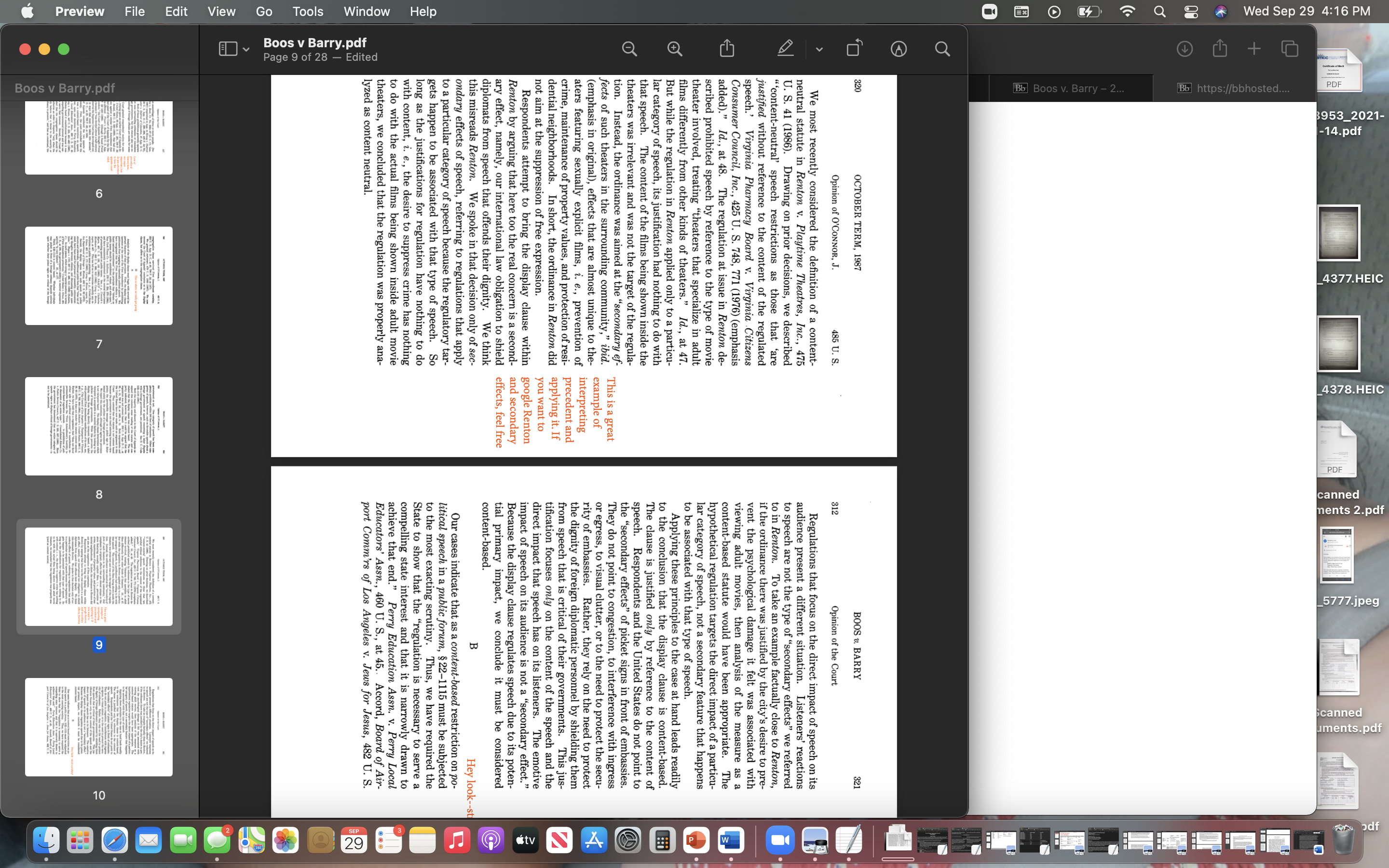
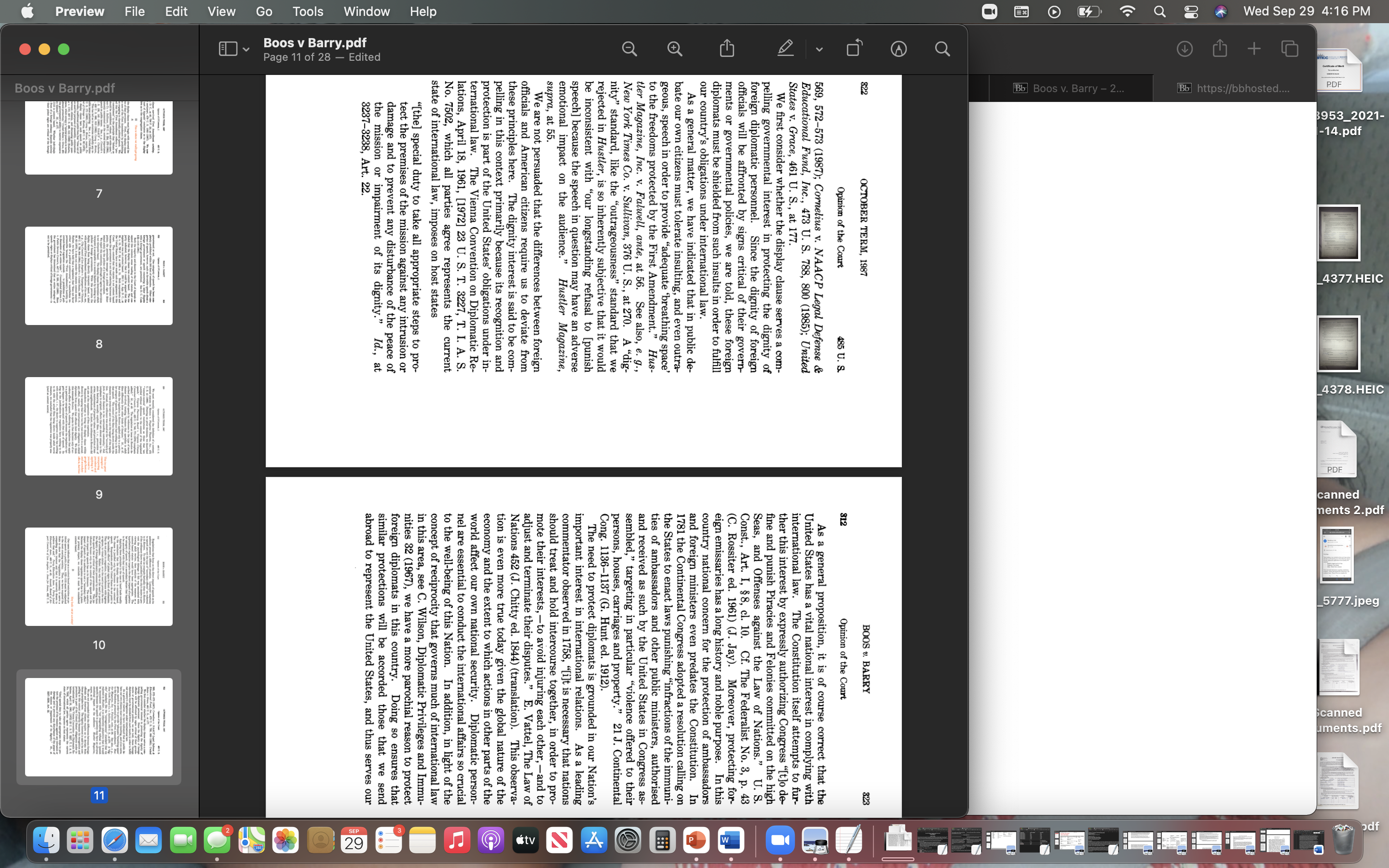
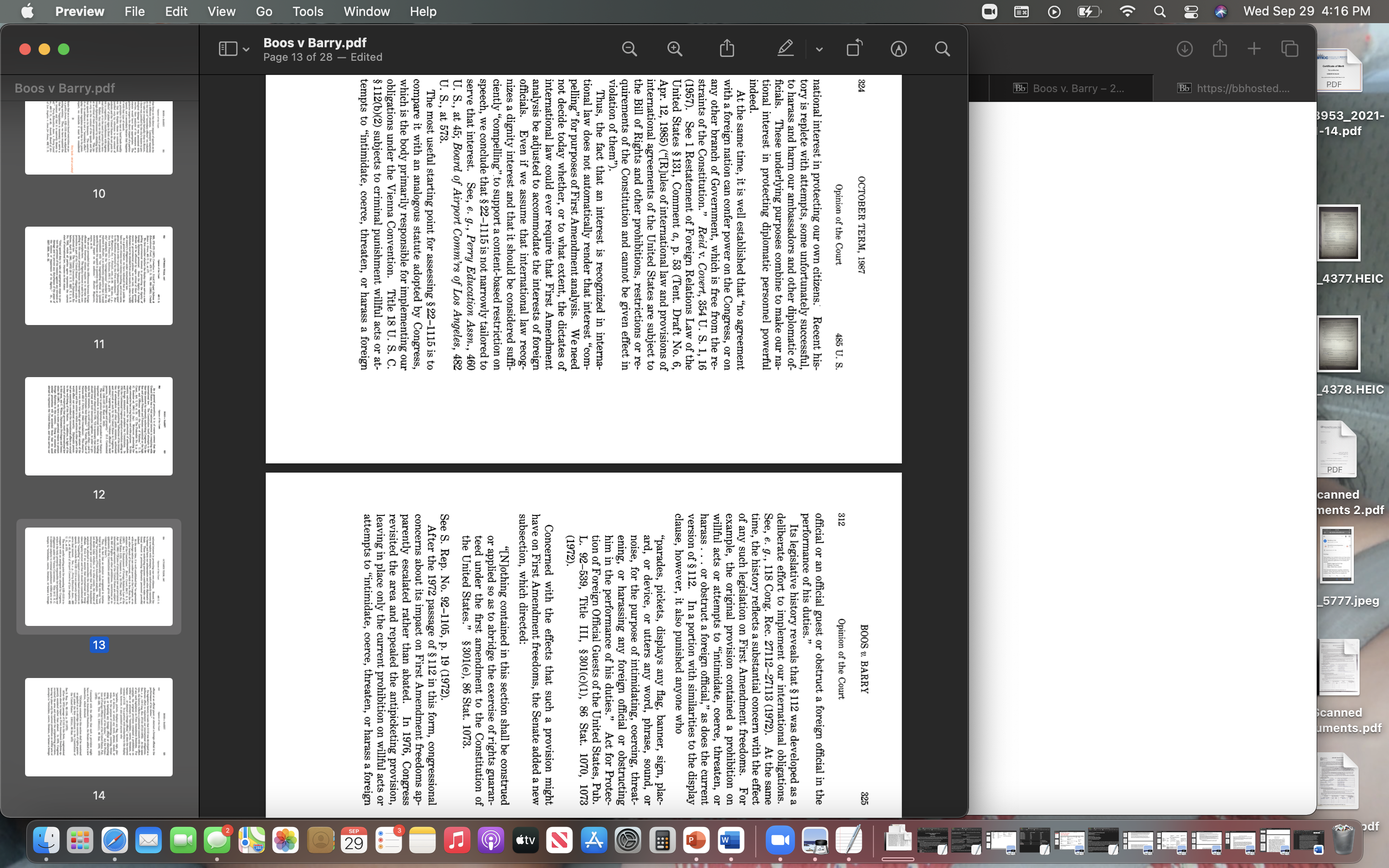
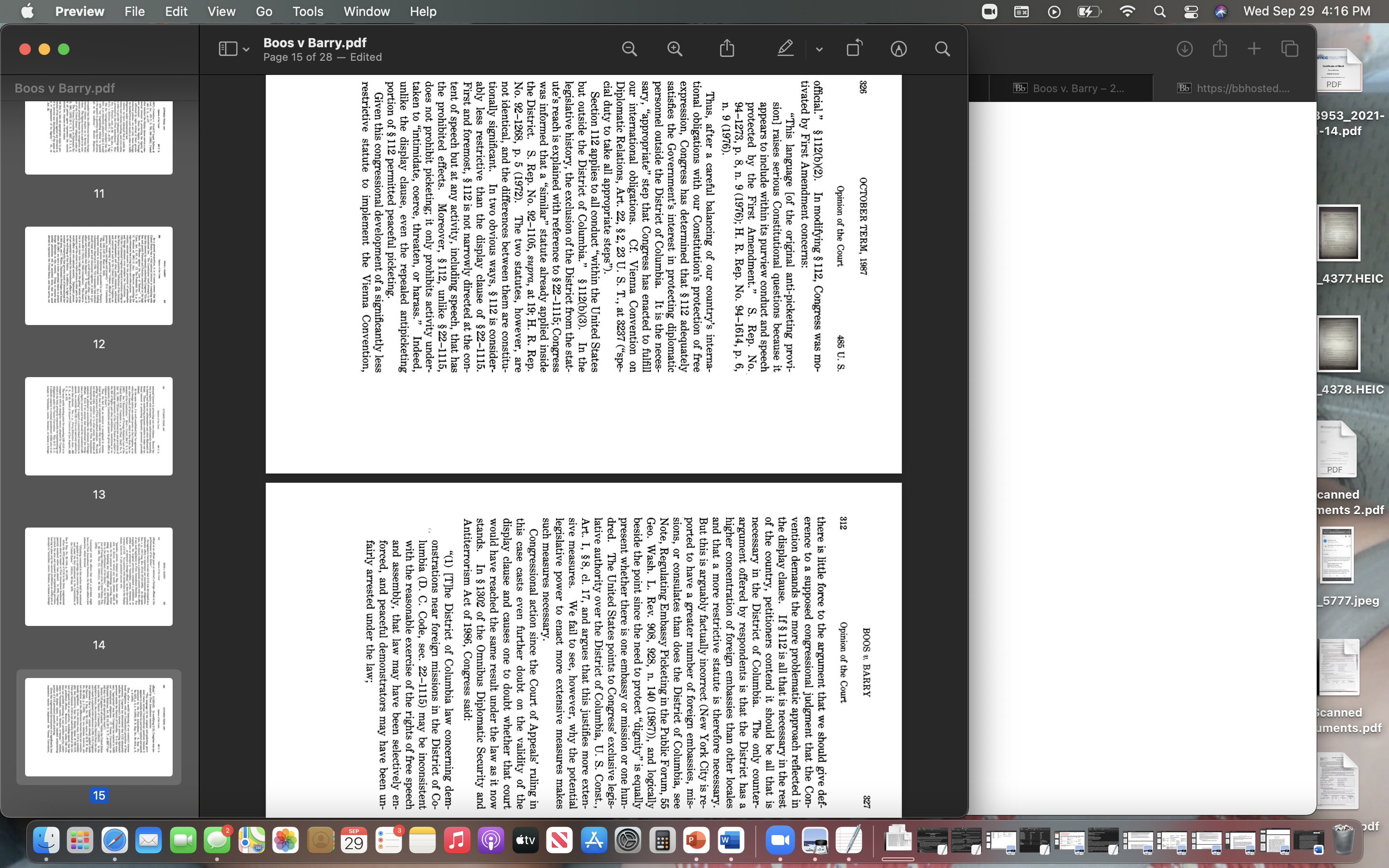
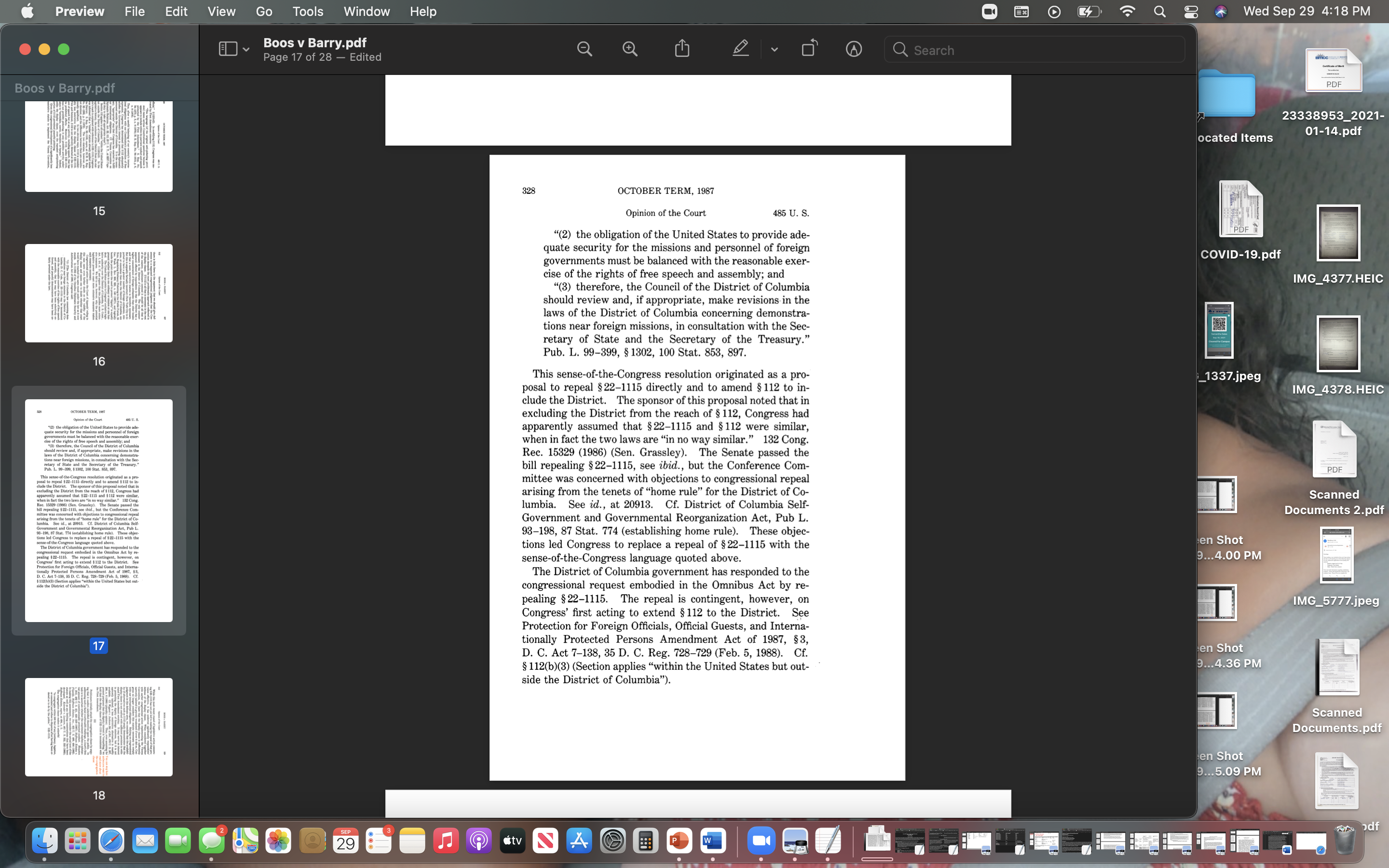
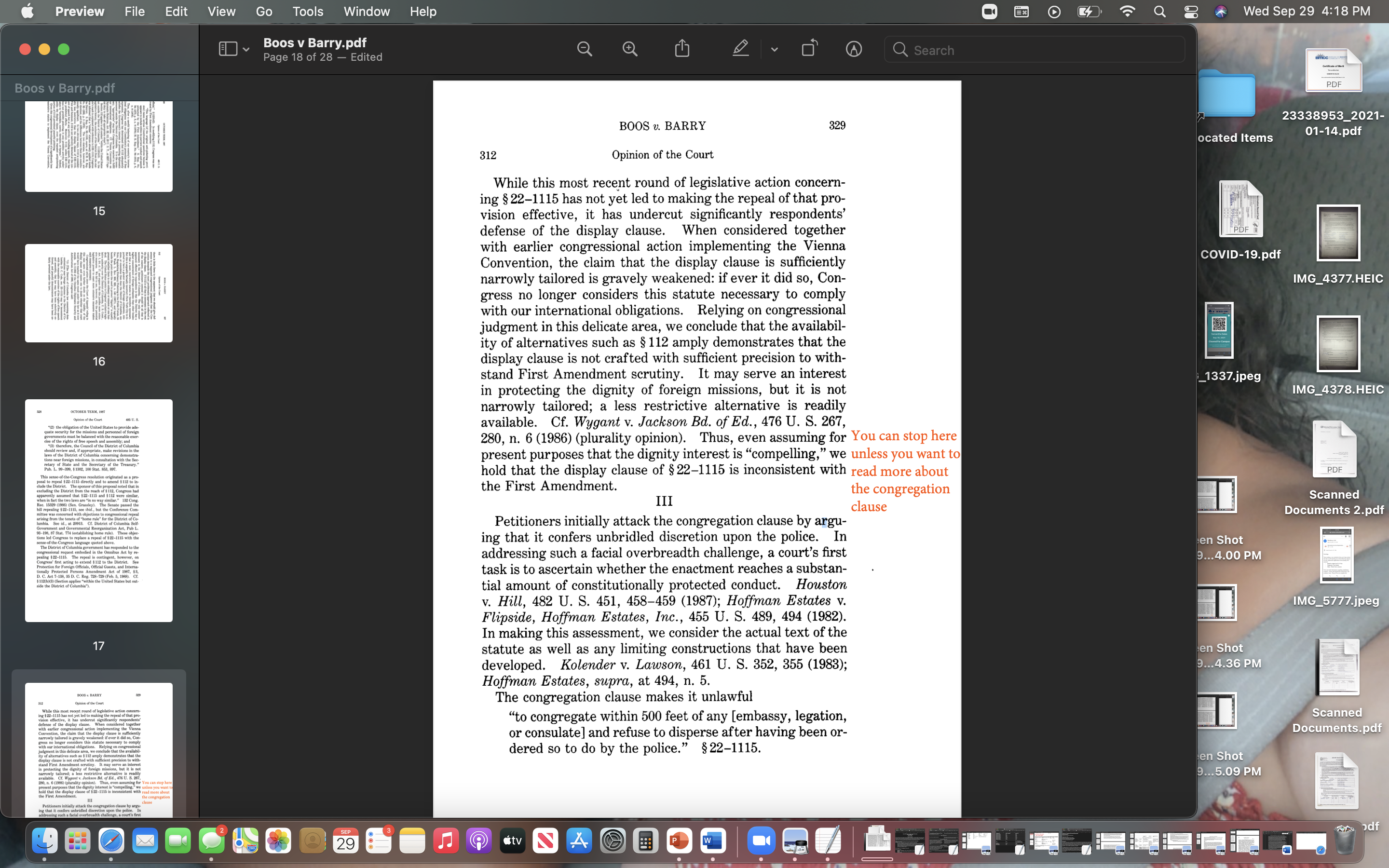

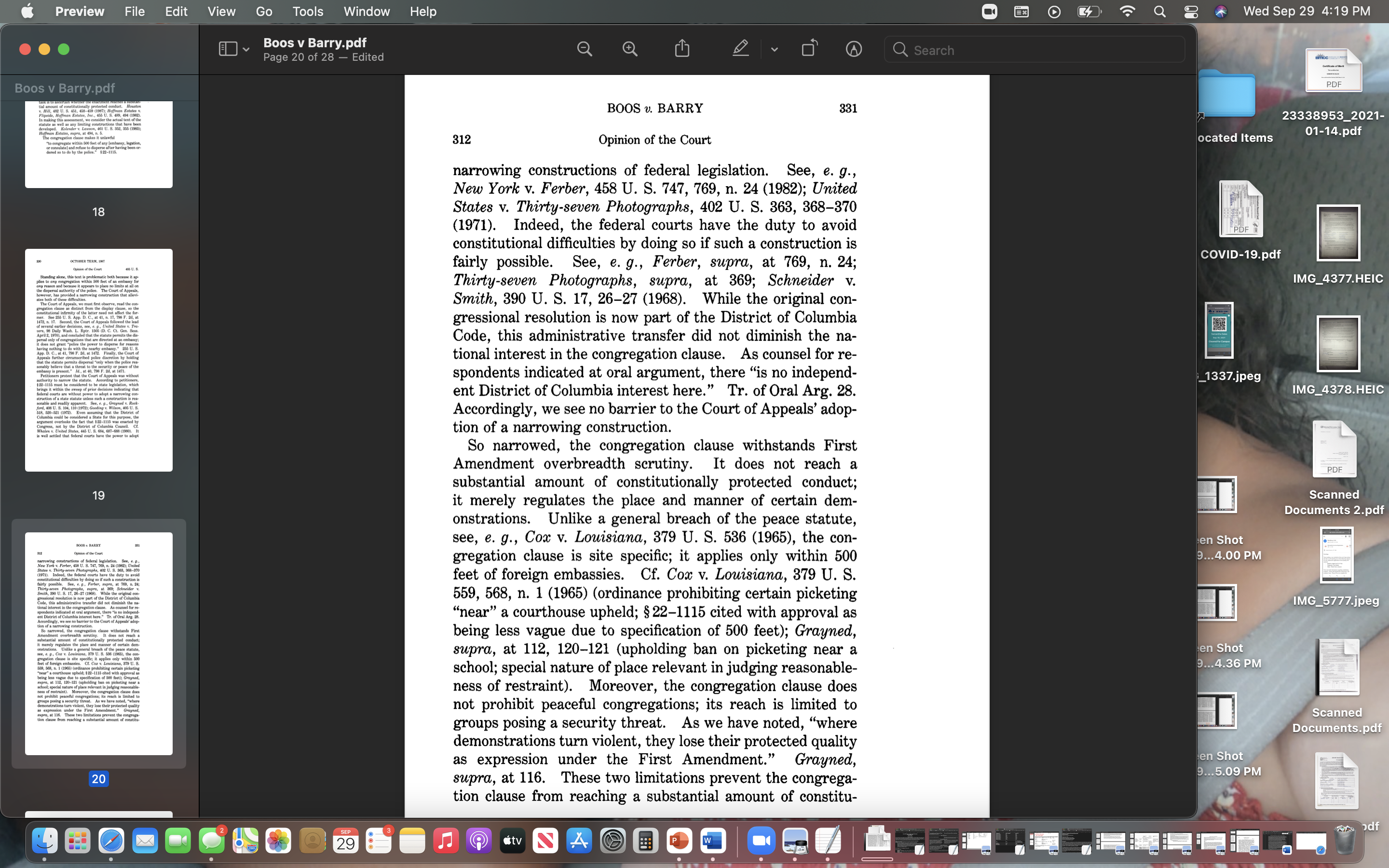
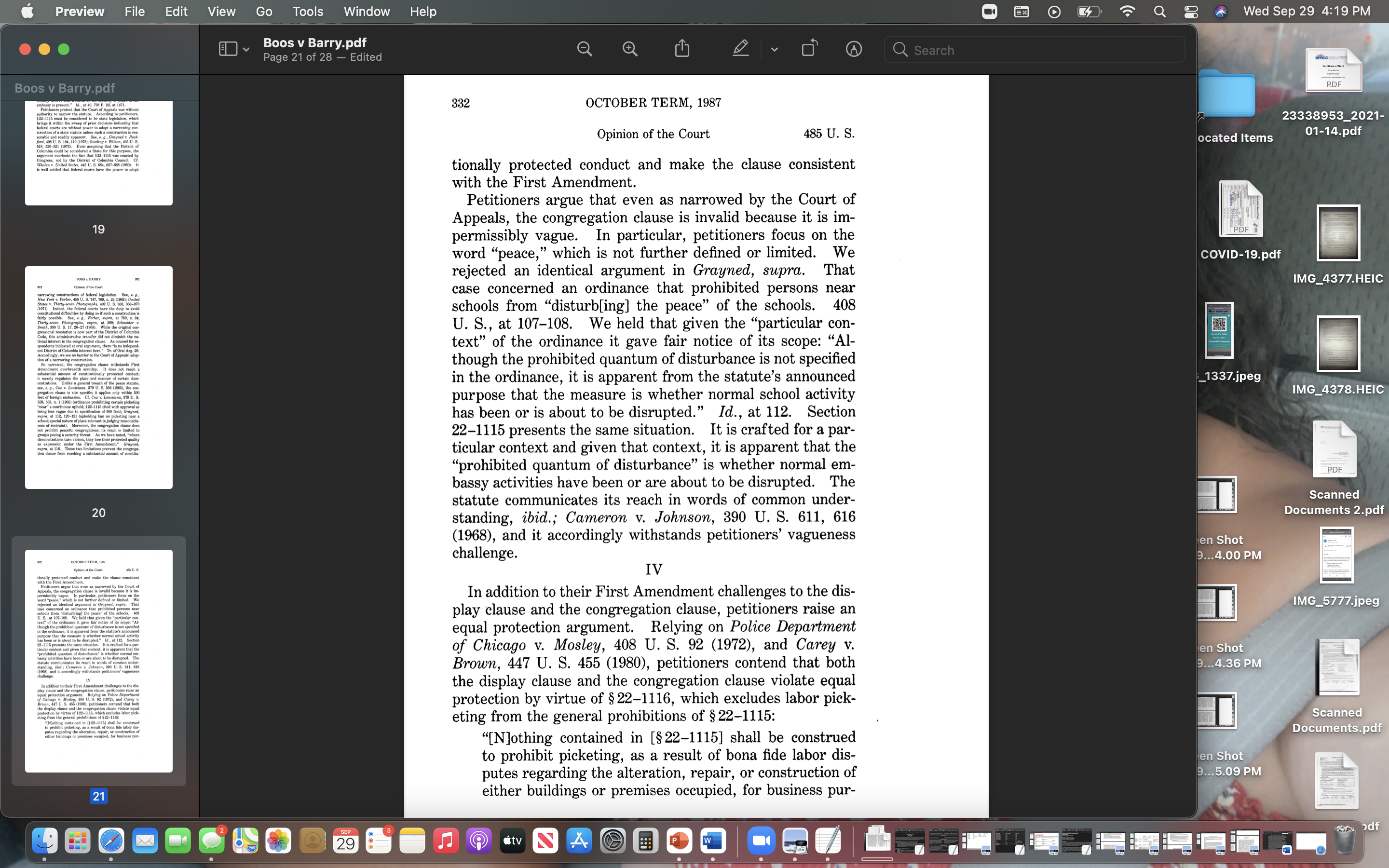

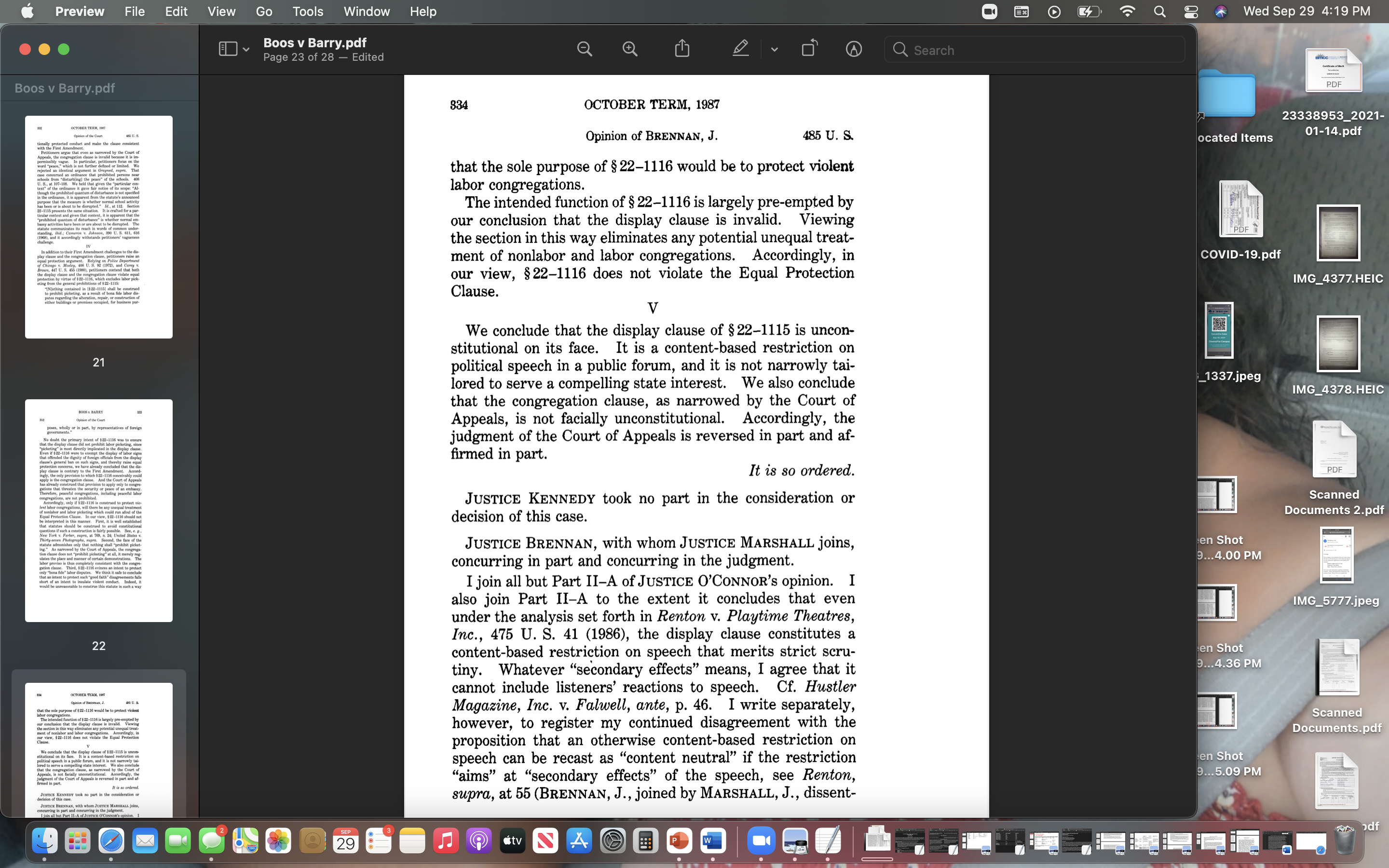
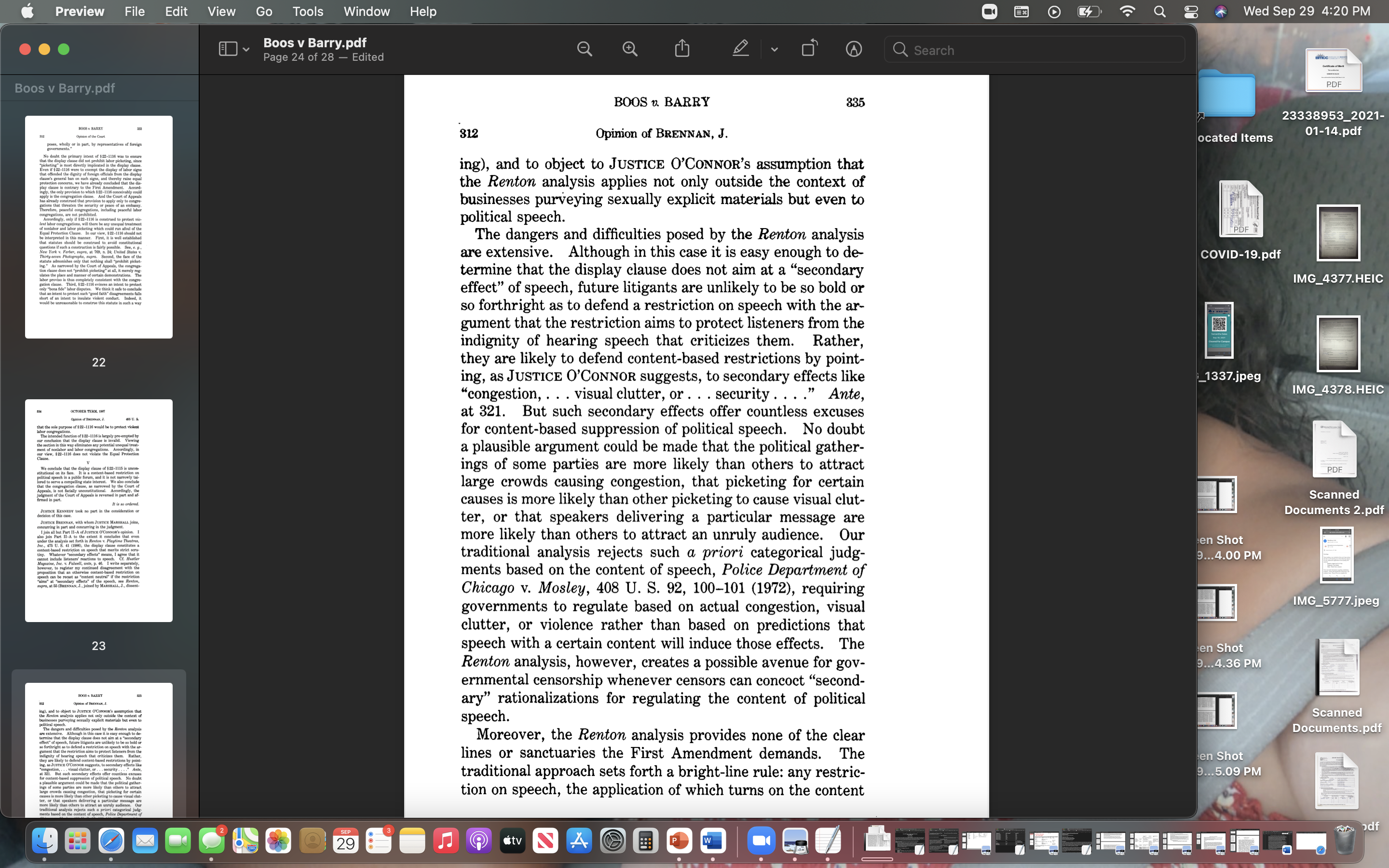
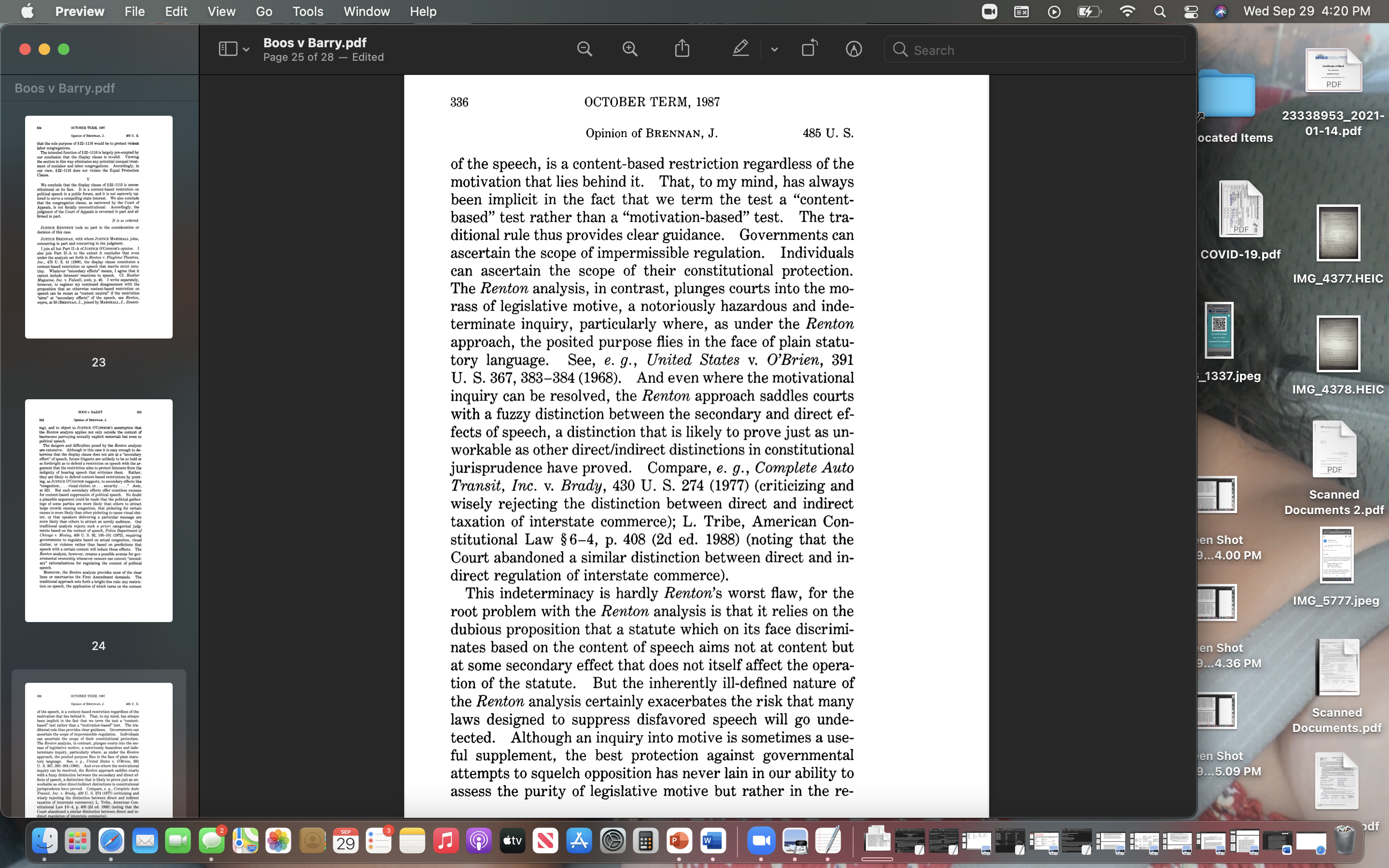
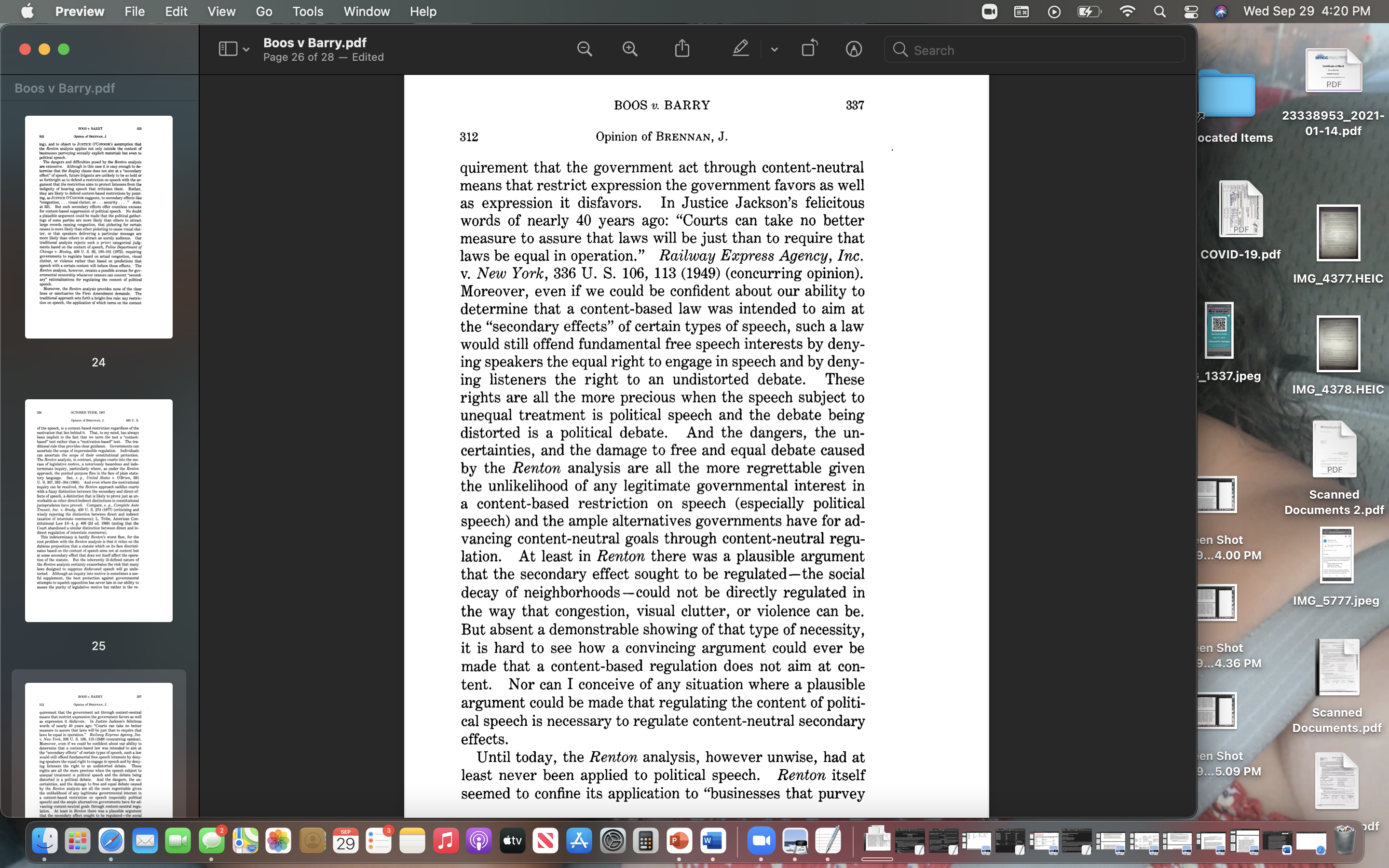
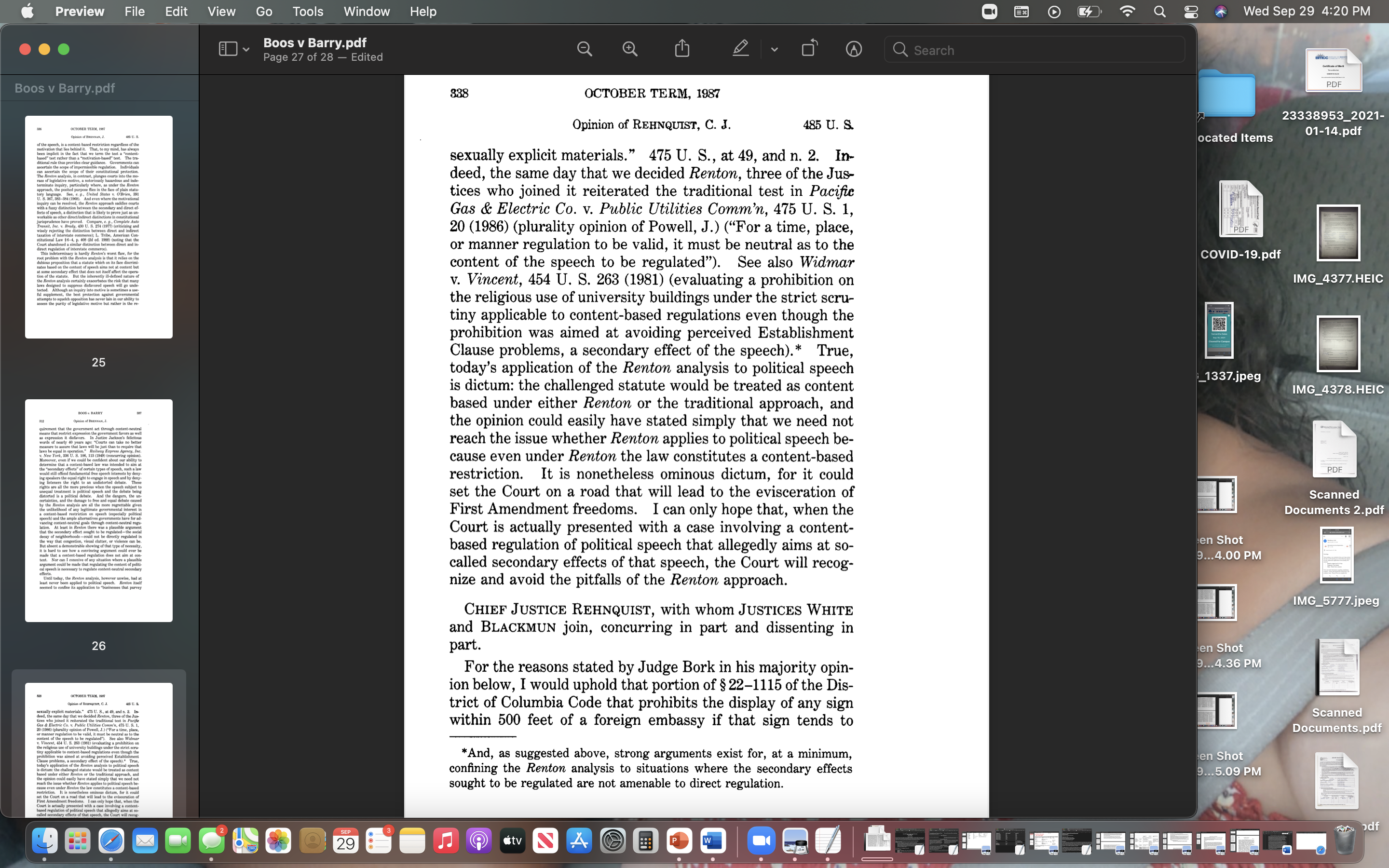
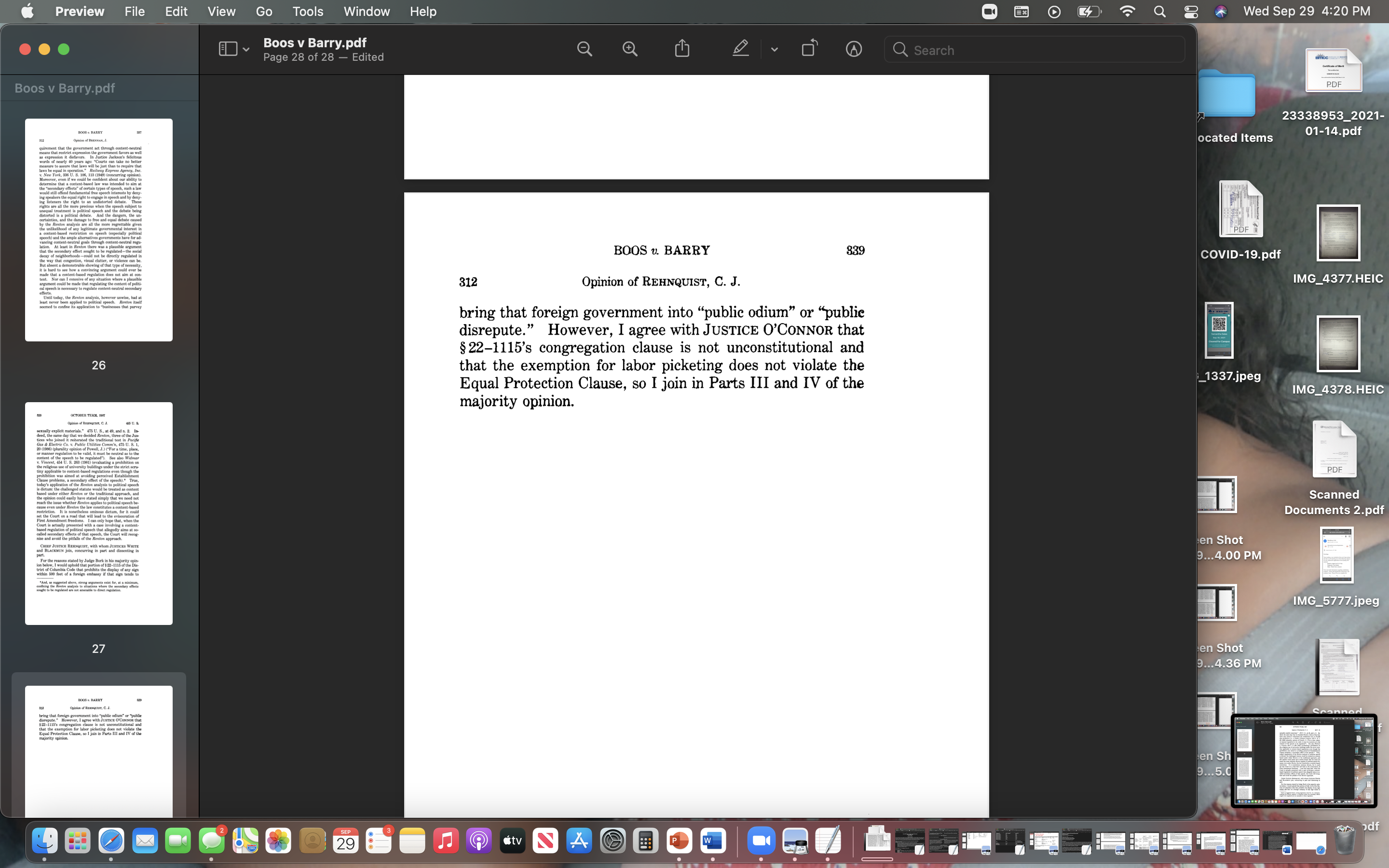
Content, Time, Place, and Manner
This week, we make our turn into case law, starting with two important Supreme Court opinions from the 1980s. In Clark v. CCNV, the Court considered a regulation that prevented sleeping/camping in National Parks?in this case applied to Lafayette Park on the National Mall. In Boos v. Barry, the Court considered a D.C. regulation which banned displaying signs critical of foreign governments within 500 feet of their embassies. Clark is pretty clear and straightforward, but Boos is a bit of a quagmire, with a split opinion where the Justices are in wide disagreement about different elements. So, as you read, remember to keep your eyes on the prize. What are the free speech considerations, and how do the Justices talk about them?
You should read Justice White's majority opinion in Clark first, maybe sit with it a bit, and then turn to Justice Marshall's dissent (which is a good one). As you read both, look for two key things-1) the holding/what the Court ruled and why, and 2) how they justified that holding. In other words, all those tools from the first several weeks about narratives, rhetorical situation, etc?see if any of them help you pick up on how the opinions become persuasive. Then, after that take a look at Boos v. Barry. It's a bit more complex, so don't worry about the "congregation clause" (you can skip parts 2 and 3 of Justice O'Connor's opinion). As you read that, same questions: what's going on here with public forums, "classically political speech," and any persuasive appeals/moves you see. Answers the following key questions. Remember that stronger responses will integrate textual evidence and go beyond what can be gleaned from Wikipedia or the syllabus of the opinion.
1) What is the holding in Clark v. CCNV and what justification did the Court offer for that ruling?
2) Why does Justice Marshall dissent from the ruling, and what is his primary disagreement with the majority about free speech in this specific case?
3) How do both opinions build persuasive or rhetorical force? In other words, what do you see going on in how they justify their arguments (I'm not playing "guess something specific" here; I'm looking to see what you're picking up).
4) What's the holding in Boos v. Barry and what justification does Justice O'Connor offer for this ruling?
Reading # 1
Okay, here we go. Not reading everything but focus on the majority and Marshall's dissent
OCTOBER TERM, 1983
Syllabus
CLARK,SECRETARY OF THEINTERIOR,ET AL.
v.COMMUNITY FORCREATIVENON-VIOLENCEETAL.
CERTIORARITO THE UNITED STATES COURT OF APPEALS FOR
THE DISTRICT OF COLUMBIA CIRCUIT
No. 82-1998. Argued March21,1984-Decided June 29,1984
In 1982, the NationalParkService issued a permit to respondent Commu- nity for Creative Non-Violence (CCNV) to conduct a demonstrationinLafayetteParkand the Mall, which are National Parks in theheartofWashington,D. C. The purpose of the demonstration was to callatten-tion to the plight of the homeless, and the permit authorized the erection of two symbolictentcities. However, theParkService, relying onitsregulations-particularlyonethatpermits "camping" (defined as includ- ing sleeping activities) only in designated campgrounds, no campgroundshavingever been designated in Lafayette Park or theMall-deniedCCNV'srequest thatdemonstrators be permitted to sleep inthe sym-bolictents.CCNV and the individual respondents then filedan actionin Federal District Court, alleging,inter alia,thatapplication oftheregulations topreventsleeping in thetentsviolated theFirstAmend- ment. The District Court granted summary judgment for theParkService,butthe Court of Appeals reversed.
Held:The challenged application of theParkService regulations does not violate theFirstAmendment. Pp.293-299.
(a) Assumingthatovernight sleeping in connection with thedem-onstration is expressive conduct protected to someextentby theFirstAmendment, the regulation forbidding sleeping meets the require-mentsfor a reasonable time, place, or manner restriction of expression,
whether oral,written,or symbolized by conduct. The regulationisneutral with regard to the message presented, and leaves open ample alternative methods of communicating the intended messageconcerningthe plight of the homeless. Moreover, the regulation narrowlyfocusesonthe Government's substantialinterestin maintaining the parks in theheartof the Capital in anattractiveand intact condition, readily available to the millions of people who wish to see and enjoy thembytheirpresence. To permit camping would be totally inimical to these purposes. The validity of the regulation need not be judged solelybyreference to the demonstrationathand, and none of its provisionsare
unrelatedto the endsthatit was designed to serve. Pp. 293-298.
(b) Similarly, the challenged regulation is also sustainable asmeetingthe standards for a valid regulation of expressive conduct.Aside from its impact on speech, a rule against camping or overnight sleeping in public parks is not beyond the constitutional power of the Government to enforce. And as noted above,thereis a substantial Governmentinter-est, unrelated to suppression of expression, in conserving parkproperty thatis served by the proscription of sleeping. Pp.298-299.
227 U. S. App. D. C.19,703 F. 2d 586, reversed.
WHITE,J.,delivered the opinion of the Court, in whichBURGER,C. J., andBLACKMUN, POWELL,REHNQUIST, STEVENS,andO'CONNOR,JJ.,joined.BURGER,C.J.,filed a concurring opinion,post,p. 300.MAR-
SHALL,J., filed adissentingopinion, inwhichBRENNAN,J., joined,post,p. 301.
Deputy Solicitor General Batorarguedthecause forpetitioners.With him on the briefs wereSolicitorGeneralLee,Assistant Attorney GeneralMcGrath,AlanI.Horowitz,
Leonard Schaitman,andKatherineS.Gruenheck.
Burt Neubornearguedthecause forrespondents.With him onthe briefwereCharlesS.Sims, Laura Macklin,
ArthurB.Spitzer,andElizabeth Symonds.*
JUSTICE WHITE deliveredtheopinion oftheCourt.
The issue inthiscase iswhethera NationalParkService regulation prohibiting camping in certain parks violatesthe FirstAmendment when applied to prohibitdemonstrators
from sleeping inLafayette Parkand the Mall in connection with ademonstrationintended to callattentiontotheplight ofthehomeless. We holdthatit does not andreverse the contrary judgmentoftheCourt of Appeals.
I
Just by the by, notice how each opinion begins their narrative/ opinions.
TheInterior Department,throughtheNationalParkService, is charged with responsibility forthemanagement and maintenance oftheNationalParksand is authorized to promulgate rules and regulations fortheuse ofthe parksin accordance withthepurposes for whichtheywere established.
-------------------------------
*OgdenNorthropLewisfiled abrieffor the National Coalition for the Homeless asamicus curiaeurging affirmance.
Opinion of the Court
16U. S.C. 1,la-1,3.'The network of NationalParksincludestheNational Memorial-core parks,Lafayette ParkandtheMall, which aresetinthe heartof Washington, D. C., and which are unique resourcesthat the FederalGov-ernmentholds intrustfortheAmerican people.Lafayette Parkis a roughly 7-acre square located across Pennsylvania Avenue fromtheWhite House. Although originallypartoftheWhite House grounds,PresidentJeffersonsetit aside as aparkfortheuse ofresidentsand visitors.Itis a "gardenparkwith a...formal landscaping of flowers andtrees,with fountains, walks and benches." NationalParkService, U. S.Departmentofthe Interior,White House andPresi- dent's Park,Resource Management Plan 4.3 (1981). The Mall is astretchof land running westward fromtheCapitol totheLincoln Memorial some two miles away.ItincludestheWashington Monument, aseriesof reflecting pools,trees,lawns, andother greenery. Itis bordered by,interalia,theSmithsonianInstitutionandtheNational Gallery ofArt.Boththe ParkandtheMall were included in MajorPierre L'Enfant'soriginal plan fortheCapital. Both are visited byvastnumbers of visitors from aroundthecountry, as well as by large numbers ofresidentsoftheWashington metro- politanarea.
Under theregulations involved in this case, campinginNationalParksispermittedonly in campgrounds designated forthatpurpose. 36 CFR 50.27(a) (1983). No such camp-grounds haveeverbeen designated inLafayette ParkortheMall. Camping is defined as
"theuse of park land for living accommodation purposes such as sleeping activities, or makingpreparationsto sleep (includingthelaying down of bedding forthe pur-
----------------------
'The Secretary is admonished to promote and regulate the use of the parks by such means as conform to the fundamental purpose of the parks, which is "to conserve the scenery and the natural and historic objects and the wild life therein...in such manner and by such means as will leave them unimpaired for the enjoyment of future generations." 39Stat.535, as amended,16U. S. C. 1.
pose of sleeping), orstoringpersonal belongings, or mak- ing any fire, or using anytentsor. ..other structure...for sleeping or doing any digging orearthbreaking or carrying on cooking activities."Ibid.
These activities,theregulation provides,
"constitutecamping whenit reasonablyappears, inlight
of allthecircumstances,that the participants,in con- ductingtheseactivities, are in fact usingthe areaas a living accommodationregardlessofthe intentofthe participantsorthe natureof anyotheractivitiesinwhichtheymay also be engaging."Ibid.
Demonstrations fortheairing of views or grievances areper- mitted in the Memorial-core parks, but for the most partonlybyParkServicepermits.36CFR50.19(1983).Tempo-rary structuresmay be erected for demonstration purposesbut may not be used for camping.36CFR 50.19(e)(8)(1983).2
In1982,the ParkService issued a renewablepermittorespondentCommunity forCreativeNon-Violence(CCNV)to conduct awintertimedemonstration inLafayette ParkandtheMall forthepurpose ofdemonstrating theplight ofthe
-------------------------------
Section50.19(e)(8), as amended, prohibits the use of certaintemporary
structures:
"In connection with permitted demonstrations or special events, tempo-rary structuresmay be erected for the purpose of symbolizing a messageormeeting logistical needs such as first aid facilities, lost children areas or the provision ofshelterfor electrical andothersensitive equipment or dis- plays. Temporarystructuresmay not be used outside designated camping areas for living accommodation activities such as sleeping, or making preparations to sleep (including the laying down of bedding forthepurpose of sleeping), orstoringpersonal belongings, or making any fire, or doing any digging orearthbreaking or carrying on cooking activities. The above-listed activities constitute camping when it reasonably appears, in light of all the circumstances,thatthe participants, in conducting these activities, are in fact using the area as a living accommodation regardlessoftheintentof the participants or the nature of anyotheractivities in which they may also be engaging."
homeless. Thepermitauthorizedtheerection of two sym- bolictentcities: 20tentsinLafayette Park thatwould accom- modate 50 people and 40tentsintheMall with a capacityofup to100.TheParkService, however, relying ontheabove regulations, specifically denied CCNV'srequest thatdemon-stratorsbepermittedto sleep inthesymbolictents.
CCNV and several individualsthenfiled an action toprevent theapplication oftheno-camping regulations totheproposed demonstration, which, it was claimed, was not covered bytheregulation.Itwas also submittedthat theregulations were unconstitutionally vague, had been dis- criminatorily applied, and could not be applied to prevent sleeping inthe tentswithout violatingthe FirstAmendment. TheDistrictCourtgrantedsummaryjudgmentin favorofthe ParkService. The Court of Appeals,sittingen banc,reversed.Community for Creative Non-Violencev.Watt,227 U. S. App. D.C. 19, 703F.2d 586 (1983). The 11judgesproduced6opinions. Six ofthe judgesbelievedthatapplication oftheregulations so as topreventsleeping inthe tentswould infringethe demonstrators' FirstAmendmentrightof free expression. Theotherfivejudgesdisagreed and would have sustainedtheregulations as applied to CCNV's proposed demonstration.' Wegranted theGovernment's petition forcertiorari,464 U. S.1016(1983), and nowreverse.
--------------------------------
Theper curiamopinion preceding the individual opinions described the lineup of the judges as follows:
"Circuit Judge Mikva files an opinion, in which Circuit Judge Wald con- curs, in support of a judgment reversing. Chief Judge Robinson and Cir- cuit Judge Wright file astatementjoining in the judgment and concurring in Circuit Judge Mikva's opinion with a caveat. Circuit Judge Edwards filesan opinion joininginthe judgment and concurring partiallyinCircuitJudge Mikva's opinion. Circuit Judge Ginsburg files an opinion joining in thejudgment.Circuit Judge Wilkey files a dissenting opinion, in whichCircuit Judges Tamm, MacKinnon, Bork andScaliaconcur. Circuit Judge Scaliafiles adissenting opinion,inwhich Circuit Judges MacKinnon and Bork concur."227 U. S.App.D. C.,at 19-20,703F.2d,at 586-587.
'As a threshold matter,wemust address respondents' contention that their proposed activitiesdonotfallwithin the definition of "camping" found
Opinion of the Court
II
(Okay, here begins the real argument. Note that they don't contest that sleeping is "expressive conduct)
We need not differ with the viewofthe Court of Appeals that overnight sleepinginconnection with the demonstration is expressive conduct protected tosomeextent by the First Amendment.5We assume for present purposes, butdo notdecide, that suchisthe case,cf.United Statesv.O'Brien,391 U. S. 367, 376 (1968),but this assumption only begins the inquiry. Expression, whether oral or written or symbolized by conduct, is subject to reasonable time, place, or manner restrictions. We have often noted that restrictionsofthis kind are valid provided that they are justified without refer- ence to the contentofthe regulated speech, that they are narrowly tailored to serveasignificant governmental inter- est, and that they leave open ample alternative channelsforcommunicationofthe information.City Council of LosAn-gelesv.TaxpayersforVincent,466 U. S. 789 (1984);United Statesv.Grace,461 U. S. 171 (1983);Perry EducationAssn.v.PerryLocalEducators'Assn.,460 U. S. 37,45-46(1983);Heffronv.InternationalSocietyfor KrishnaConsciousness,
----------------------------
in the regulations. None of the opinions below accepted this conten- tion, andatleast nine of the judges expressly rejected it.Id.,at24, 703 F. 2d,at591 (opinion of Mikva, J.);id.,at42, 703 F. 2d,at609 (opinionofWilkey,J.).We likewise find the contention to be withoutmerit.It can- not seriously be doubtedthatsleeping intentsfor the purpose of express- ing the plight of the homeless falls within the regulation's definitionofcamping.
5
We reject the suggestion of the plurality below, however,thatthe
burden on the demonstrators is limited to "the advancement of a plausible contention"that theirconduct is expressive.Id.,at26, n.16,703 F. 2d,at593, n.16.Although it is common to place the burden upon the Govern- ment tojustifyimpingements onFirstAmendmentinterests,it is the obligation of the person desiring to engage in assertedly expressive conduct to demonstratethattheFirstAmendment even applies. To hold otherwise would be to create a rulethatall conduct is presumptively expressive. In the absence of a showingthatsuch a rule is necessary to protect vitalFirstAmendmentinterests,we decline to deviate from the general rulethatone seeking relief bears the burden of demonstrating that he is entitled toit.
Inc.,452U. S. 640, 647-648(1981);Virginia PharmacyBoardv.Virginia Citizens Consumer Council,Inc.,425
U.S. 748,771(1976);Consolidated EdisonCo.v.PublicServiceComm'n ofN.Y.,447 U.S.530, 535 (1980).
Itis alsotrue thata message may be delivered byconductthatis intended to be communicative andthat,in context,would reasonably be understood bytheviewerto be com-municative.Spencev.Washington,418 U. S.405 (1974);Tinkerv.DesMoinesSchoolDistrict,393 U.S.503 (1969).Symbolicexpression of this kind may be forbiddenorregu-lated iftheconductitselfmay constitutionally beregulated,iftheregulation is narrowly drawn tofurtherasubstantialgovernmentalinterest,and if theinterestisunrelatedtothesuppression of free speech.United Statesv.O'Brien,supra.
Petitionerssubmit, astheydid intheCourt ofAppeals,that theregulation forbidding sleeping is defensibleeitherasatime,place, or mannerrestrictionor as a regulationof sym-bolic conduct.We agree withthatassessment. Thepermitthatwasissued authorizedthedemonstrationbutrequiredcompliancewith 36 CFR 50.19 (1983), which prohibits"camping"on park lands,thatis,theuseofparklandsfor
livingaccommodations, such as sleeping,storingpersonal belongings, making fires, digging, or cooking.These provi-sions,includingtheban on sleeping, are clearly limitationsonthemanner in which the demonstration could be carriedout.Thatsleeping, likethesymbolictentsthemselves,may beexpressiveandpartofthemessage delivered bythedem-onstrationdoes not maketheban any less a limitationonthemannerofdemonstrating,for reasonable time, place, orman-nerregulations normally havethepurpose anddirect effectof limitingexpressionbutareneverthelessvalid.CityCouncilofLosAngelesv.Taxpayers for Vincent,supra;Heffronv.InternationalSociety for Krishna Consciousness,Inc.,supra;Kovacs v.Cooper,336 U.S.77(1949).Neitherdoesthefactthatsleeping,arguendo,may be expressive conduct,rather thanoral orwrittenexpression,render thesleeping prohibition any less a time, place, or manner regula- tion. Tothecontrary,the ParkServiceneither attemptsto ban sleeping generally nor to ban it everywhere inthe parks.It has established areas for camping and forbidsitelsewhere, including LafayetteParkandtheMall. Consid- ered as such, we have very little trouble concludingthat the ParkService may prohibit overnight sleeping intheparks involvedhere.
Therequirement thatthe regulation becontent-neutralisclearly satisfied. The courts below acceptedthatview, and it is not disputed herethat theprohibition on camping, andonsleeping specifically, is content-neutral and is not being ap- plied because of disagreement withthemessagepresented.' Neitherwastheregulation faulted, nor could it be, onthegroundthatwithout overnight sleepingtheplight ofthehomeless could not be communicated inotherways. The regulation otherwiseleft thedemonstrationintact,withitssymbolic city, signs, andthepresence of those who were will- ing totake their turnsin a day-and-night vigil. Respondents do notsuggest that therewas, or is, anybarrierto delivering tothemedia, or to the public byothermeans,theintended message concerningtheplight ofthehomeless.
--------------------------------------
Respondentsrequest thatwe remand to the Court of Appeals for reso-
lution oftheirclaimthatthe District Court improperlygrantedsummary judgment on the equal protection claim. Brief for Respondents91,n. 50. They contendthat therewere disputed questions of fact concerning the uniformity of enforcement of the regulation, claimingthatother groups have slept in the parks. The District Court specifically foundthatthe regulations have been consistently applied and enforced in a fair and non- discriminatory manner. App. toPet.for Cert. 106a-108a. Only5ofthe11judges in the Court of Appeals addressed the equal protection claim. 227 U. S. App. D. C.,at43-44, 703 F. 2d,at610-611 (opinion of Wilkey,J.,joined by Tamm, MacKinnon, Bork, and Scalia,JJ.).Our review of the record leads us to agree withtheirconclusionthat thereis no genuine issue of material fact andthatthe mostthatrespondents have shown are isolated
instances of undiscovered violations of the regulations.
Itis alsoapparentto usthat theregulationnarrowlyfocusesontheGovernment'ssubstantial interestin maintain-ingtheparksinthe heartof our Capital in anattractiveandintactcondition, readily available tothemillionsof peoplewhowish to see and enjoy them bytheirpresence. Toper-mitcamping-using theseareas as living accommodations-wouldbe totally inimical tothesepurposes, as wouldbereadilyunderstood by those who havefrequentedtheNa-tionalParksacrossthecountry and observedthe unfortunateconsequences oftheactivities of those whorefuse to confinetheircamping to designated areas.
Itis urged by respondents, andthe Courtof Appealswasofthisview,thatifthesymbolic city oftentswasto beper-mitted and ifthe demonstratorsdid not intendto cook, dig,orengage in aspects of campingother thansleeping,theincrementalbenefit totheparks could notjustify thebanon sleeping,which was here an expressive activity saidtoenhancethemessage concerningtheplight ofthepoor andhomeless.We cannot agree. Inthefirst place, weseri-ouslydoubtthat the FirstAmendmentrequires theParkService topermita demonstration inLafayetteParkandtheMallinvolving a 24-hour vigil andtheerection oftentstoaccommodate150people.Furthermore,although wehaveassumed forpresentpurposesthat thesleepingbannedinthiscase would have an expressive element,itis evidentthatitsmajor value to this demonstration would befacilitative.Withoutapermitto sleep, it would be difficult toget thepoorand homeless toparticipateor to bepresentatall. Thismuchisapparentfromthe permitapplication filed byre-spondents: "Withouttheincentive of sleeping space ora hotmeal,thehomeless would not come tothesite." App.14.Thesleeping ban, if enforced, wouldthuseffectively limitthenature,extent,and duration ofthedemonstration and tothatextenteasethe pressureontheparks.
Beyondthis, however, it is evident from our casesthat thevalidityof this regulation need not bejudgedsolelybyrefer-ence to the demonstration at hand.Heffronv.InternationalSocietyfor KrishnaConsciousness, Inc.,452 U. S.,at 652-653. Absent the prohibitiononsleeping, there wouldbeother groupswhowould demand permission to deliveranasserted message by campinginLafayette Park. Some of them would surely have as crediblea claim inthis regardasdoes CCNV, and the denial of permits to still others would present difficult problems for the Park Service. With the prohibition, however, as is evident in the case before us,atleast some around-the-clock demonstrations lasting for daysonendwillnot materialize, otherswillbe limited insizeand duration, and the purposesofthe regulationwillthusbematerially served. Perhaps these purposes would be more effectively and notsoclumsily achieved by preventing tents and 24-hour vigils entirely in the core areas. But the Park Service's decision to permit nonsleeping demonstrations does not,inour view, impugn the camping prohibition as a valu- able, but perhaps imperfect, protection to the parks. If the Government hasalegitimate interestinensuring that the National Parks are adequately protected, which we think it has, and if the parks would be more exposed to harm without the sleeping prohibition than with it, the ban is safe from invalidation under theFirstAmendment asareasonable
regulationofthe mannerinwhichademonstration maybe
carried out. As inCity CouncilofLos Angelesv.TaxpayersforVincent,the regulation "responds precisely to the substantive problems which legitimately concern the[Gov-
ernment]."466 U. S.,at810.
We have difficulty, therefore, in understanding why the
prohibition against camping, with its banonsleeping over- night, is notareasonable time, place, or manner regulation that withstands constitutional scrutiny. Surely the regula- tion is not unconstitutionalonitsface.None of its provi- sions appears unrelated to the ends that it was designed to serve. Nor is it any less valid when applied to prevent camping in Memorial-core parks by thosewhowish to demon-strateand deliver a message tothepublic andthe central Government. Damage to the parks as well as their partialinaccessibility toothermembers ofthepublic can as easilyresultfrom camping bydemonstratorsas by nondemonstra-tors.Inneithercase musttheGovernmenttolerate it.All those who wouldresortto the parks must abide by otherwise valid rules fortheiruse,justastheymust observethetrafficlaws, sanitation regulations, and laws to preserve the publicpeace.7This is no more than a reaffirmationthatreasonable time, place, or mannerrestrictionson expression are con- stitutionally acceptable.
Contrarytotheconclusion of the Court of Appeals,the foregoing analysisdemonstrates that the ParkServiceregulation is sustainable underthefour-factorstandardofUnited Statesv.O'Brien,391U. S. 367 (1968), for validating aregulation of expressive conduct, which, inthe lastanalysisis little, if any, different from the standard applied to Time, place, and manner restrictions. No one contends that aside
-------------------------------------------------
When the Government seeks to regulate conductthatis ordinarily nonexpressiveitmay do so regardless of the situs of the application ofthe regulation. Thus, even against people who choose to violateParkService regulations for expressive purposes, theParkService may enforce regula-
tions relating to grazing animals, 36 CFR50.13 (1983); flying model planes, 50.16; gambling, 50.17; hunting and fishing, 50.18;settingoff
fireworks, 50.25(g); and urination, 50.26(b).
Reasonable time, place, or manner restrictions are valid even though
they directly limit oral orwrittenexpression.Itwould be odd to insistona higher standard for limitations aimedatregulable conduct and having only an incidental impact on speech. Thus, if the time, place, or mannerrestrictionon expressive sleeping, ifthatis what is involved in this case, sufficiently and narrowly serves a substantial enough governmentalinter-est to escapeFirstAmendment condemnation, it is untenable to invalidate it underO'Brienon the groundthatthe governmentalinterestis insuffi- cient towarrantthe intrusion onFirstAmendment concerns orthat thereis an inadequate nexus between the regulation and theinterestsought to be served. We notethatonly recently, in a case dealing with the regula- tion of signs, the Court framed the issue underO'Brienand then based a crucialpartofitsanalysis on the time, place, or manner cases.City Coun-
fromitsimpact on speech a rule against camping or overnight sleeping in public parks is beyondtheconstitutional power oftheGovernment to enforce. And forthereasons we have discussed above,thereis asubstantialGovernmentinterestin conservingpark property,aninterest thatis plainly served by, andrequiresforitsimplementation, measures such astheproscription of sleepingthatare designed to limitthewear andtearon parkproperties. That interestisunre-lated to suppression of expression.
We are unmoved bytheCourt of Appeals' viewthat thechallenged regulation is unnecessary, and hence invalid, be- causethereare less speech-restrictivealternatives thatcould have satisfiedtheGovernmentinterestinpreserving parklands. There is no gainsayingthat preventingovernight sleeping will avoid a measure of actual orthreateneddamage toLafayette ParkandtheMall. The Court of Appeals' sug- gestionsthat the ParkService minimizethepossibleinjuryby reducingthesize, duration, or frequency of demonstra- tions would still curtail thetotalallowable expressioninwhichdemonstratorscould engage,whetherby sleepingorotherwise, andthesesuggestionsrepresentno morethanadisagreementwiththe ParkService over how much protec- tionthecore parksrequireor how an acceptable level ofpres-ervation is to beattained.We do not believe, however,that eitherUnited Statesv.O'Brienorthetime, place, or manner decisions assign to the judiciarythe authorityto replacethe
ParkService asthemanager oftheNation's parks or endowthe judiciarywiththecompetence tojudgehow much protec- tion ofparklands is wise and howthatlevel of conservation is to beattained.'
Accordingly,the judgmentof the Court of Appealsis
Reversed.
---------------------------------------
cilofLosAngeles v.Taxpayers for Vincent,466 U. S. 789, 804-805, 808-810 (1984).
'Wealso agree with Judge Edwards' observationthat"[t]o insist upon a judicial resolution of this case, given the facts and recordathand, argu-
OCTOBER TERM, 1983
BURGER, C.J., concurring
CHIEF JUSTICEBURGER,concurring.
I concur fully inthe Court'sopinion.
I find it difficult to conceive of what "camping" means, ifitdoes not include pitching atentand building a fire. Whether sleeping or cooking follows isirrelevant.With allitsfrail-ties, theEnglish language, as used in this country forseveral centuries,and as used inthe ParkService regulations, could hardly be plainer in informingthepublicthatcampinginLafayette Parkwas prohibited.
The actions here claimed as speech entitled totheprotec- tions ofthe FirstAmendment simply are not speech;rather, they constituteconduct. As Justice Black, who was nevertolerantof limits on speech, emphatically pointed out in hisseparateopinion inCoxv.Louisiana,379 U.S.536, 578 (1965):
"TheFirstandFourteenthAmendments,I think,take
away from government,stateand federal, all power torestrictfreedom of speech,press,and assemblywherepeople havea righttobefor suchpurposes....Picket- ing, thoughitmay be utilized to communicate ideas,isnot speech, andthereforeis not of itself protected bythe FirstAmendment." (Emphasis in original; citations omitted.)
Respondents'attemptat camping inthepark is a formof"picketing";it is conduct,not speech.Moreover,itis con-
ductthat interfereswith therightsof others to useLafayette Parkforthepurposes for which it was created.Lafayette Parkand others like it are for allthepeople, andtheir rightsare not to betrespassedeven by those who have some"state-ment" to make. Tents, fires, and sleepers, real or feigned,interferewiththe rightsof others to use our parks.Of
---------------------------
ably suggests a lack of common sense." 227 U. S. App. D. C.,at33, 703 F. 2dat600. Nor is it any clearer to us than it was to him "what has been achieved by thisratherexhausting expenditure of judicial resources."Id.,at34, 703 F. 2d,at601.
CLARKv.COMMUNITY FOR CREATIVE NON-VIOLENCE
MARSHALL,J., dissenting
course,theConstitutionguarantees thatpeople may maketheir "statements," butWashington has countless places forthekind of"statement" theserespondents sought to make.
Ittrivializesthe FirstAmendment to seek to useitas a shield inthemannerassertedhere. Andittells us some-thingabout why many people must wait fortheir"dayincourt" whenthetime of the courts is pre-empted by frivolous proceedingsthatdelaythecauses of litigants who have legiti- mate, nonfrivolous claims. This case alone has engagedthetime of 1District Judge,an en banc court of11CourtofAppealsJudges,and9Justicesof this Court.
(Here's Justice Marshall, who argued Brown v. Board and founded the NAACP legal defense arm before becoming a Justice.)
JUSTICEMARSHALL,with whomJUSTICEBRENNANjoins, dissenting.
TheCourt'sdisposition ofthiscase is marked bytwo relatedfailings.First,themajorityiseitherunwilling or unable totakeseriouslythe FirstAmendment claims advanced byrespondents. Contrarytotheimpression given
bythe majority,respondents are not supplicants seeking to wheedle an undeserved favor fromtheGovernment. They are citizens raising issues of profound public importance who have properlyturnedtothecourts forthevindicationoftheirconstitutionalrights.Second,the majoritymisappliesthe testfor ascertainingwhetherarestrainton speech qualifies as a reasonable time, place, and manner regulation. Indeterminingwhat constitutes a sustainable regulation,the majorityfails to subject the allegedinterestsoftheGovernment tothedegree of scrutinyrequiredtoensure thatexpressive activity protected bythe FirstAmendment
remains free of uneccessary limitations.
I
Theproper startingpoint for analysis ofthiscase is a recognitionthat theactivity in whichrespondentsseek toengage-sleepingin a highly public place, outside, inthe winterforthepurpose ofprotesting homelessness-issym- bolic speech protected bythe FirstAmendment. The major-ityassumes, without deciding,that the respondents'conduct is entitled to constitutional protection.Ante,at293. The problem with this assumption isthat theCourttherebyavoids examining closelythe realityofrespondents'planned expression. Themajority'sapproachdenaturesrespond- ents'asserted rightand thus makes all too easy identification of a Governmentinterestsufficient towarrant its abridg-ment. A realistic appraisal ofthecompetinginterestsat stake in this caserequiresa closer lookat the natureoftheexpressive conduct at issue andthecontext in whichthatconduct would be displayed.
In late autumn of1982,respondents sought permission to conduct a round-the-clock demonstration inLafayette Parkand ontheMall.Partofthedemonstration would include
homeless persons sleeping outside intentswithout any other amenities.1Respondents sought to begintheirdemonstra- tion on a date full of ominous meaning to any homeless person:thefirst day ofwinter.Respondents were similarly purposeful in choosing demonstration sites. The Court por-trays thesesites-theMall andLafayette Park-ina peculiar fashion. According to the Court:
"Lafayette ParkandtheMall...are unique resourcesthattheFederalGovernment holds intrustfortheAmerican people. LafayetteParkis a roughly 7-acre square located across Pennsylvania Avenue fromtheWhite House. Although originallypartoftheWhite House grounds,PresidentJeffersonset itaside as aparkfortheuse ofresidentsand visitors.Itis a 'gardenparkwith a...formal landscaping of flowers andtrees,with fountains, walks and benches.'. . .The Mall is a
-------------------------------------
The previous winter respondents had held a similar demonstrationaftercourts ruledthatthe Park Service regulations then in effect did not extend to respondents' proposed activities.Community for CreativeNon-Violencev.Watt,216 U. S. App. D. C. 394, 670 F. 2d 1213 (1982)(CCNV I).Those activities consisted of setting up and sleeping in ninetentsin Lafayette Park. The regulations at issue in this case were promulgated in direct response toCCNV I.47 Fed. Reg. 24299 (1982).
stretch of land running westward from the Capitoltothe Lincoln Memorial some two miles away.Itincludes the Washington Monument,aseries of reflecting pools, trees, lawns, and other greenery.Itis bordered by,interalia,the Smithsonian Institution and the National Gallery of Art. Both the Park and theMallwere in- cluded in Major Pierre L'Enfant's original plan for the Capital. Both are visited by vast numbers of visitors from around the country, as well as by large numbersofresidents of the Washington metropolitan area."Ante,at290.
Missing from the majority's descriptionisany inkling that Lafayette Park and theMallhave served as the sitesforsome of the most rousing political demonstrations in the Nation's history.Itis interesting to learn,Isuppose, that Lafayette Park and theMallwere both part of Major Pierre L'Enfant's original plan for the Capital. Far more pertinent, however, is that these areas constitute,inthe Government's words,"afitting and powerful forum for political expression
and political protest." Brief for Petitioners11.2
The primary3purpose for makingsleepan integral part of the demonstration was "to re-enact the central reality of
-----------------------------
Atoral argument, the Government informed the Court"thaton any
given daytherewill be an average ofthreeor so demonstrations going on" in the Mall-LafayetteParkarea.Tr.of Oral Arg.3-4.Respondents ac- curately describe LafayettePark"as the American analogue to 'Speaker's
Corner' in Hyde Park."Brieffor Respondents16,n. 25.
'Another purpose for making sleeppartof the demonstration was to enable participants to weather the rigors of the round-the-clock vigil and to
encourage other homeless persons to participate in the demonstration. As respondentsstatedintheirapplication for a demonstration permit:
"If therewas ever any question as to whether sleeping was a necessary element in this demonstration, it should be answered by now [in light ofthepreviousyear'sdemonstration]. Nomatterhow hard wetriedto get [homeless persons] to come to Reaganville [the name given to the dem- onstration by respondents], they simply would not come, until sleeping was permitted." App.14.
homelessness,"Brieffor Respondents2,and to impress upon public consciousness, in as dramatic a way as possible,thathomelessness is a widespread problem,oftenignored,thatconfrontsitsvictims with life-threatening deprivations. As oneof the homeless men seeking to demonstrate explained: "SleepinginLafayette Park orontheMall,for me,istoshow peoplethatconditions are so poor forthehomeless and poor in this citythatwe would actually sleepoutsideinthewinter toget thepoint across."Id.,at3.
In a long line of cases, this Court has affordedFirstAmendment protection to expressive conductthatqualifies as symbolic speech. See,e.g.,Tinkerv. DesMoinesSchoolDist.,393U.S.503(1969)(black armband wornbystudentsin public school asprotestagainst UnitedStatespolicyinVietnam war);Brownv.Louisiana,383 U.S.131(1966)(sit-inbyNegrostudentsin "whites only"librarytoprotestsegregation);Strombergv.California,283 U.S.359(1931)(flyingredflagas gestureofsupport for communism). Inlight ofthesurrounding context,respondents'proposed activity meets the qualifications. The Court has previously acknowledgedtheimportance of context in determining
---------------------------
Estimateson the number of homeless persons in the UnitedStatesrange from two tothreemillion. See Brief for National Coalition for the Homeless asAmicusCuriae3.Though numerically significant, the home- less are politically powerless inasmuch as they lack the financial resources necessary to obtain access to many of the most effective means ofpersua-sion. Moreover, homeless persons are likely to be denied access tothevote since the lack of a mailing address or other proof of residence within a State disqualifies an otherwise eligible citizen fromregisteringto vote.Id.,at5.
The detrimental effects of homelessness are manifold and include psychic trauma, circulatory difficulties, infectionsthatrefuse to heal, lice infesta- tions, and hypothermia.Id.,at14-15. In the extreme, exposure totheelements can lead to death; over the1983Christmas weekend in New York City,14homeless persons perished from the cold. SeeN.Y. Times, Dec.27, 1983, p. Al.,col.1.
whetheran act can properly be denominated as "speech" forFirstAmendment purposes and has provided guidance concerningtheway in which courts should"read"a context in making this determination. The leading case isSpencev.Washington,418 U. S. 405 (1974), wherethisCourt heldthatdisplaying a UnitedStatesflag with a peace symbolattachedtoitwas conduct protected bythe FirstAmendment. The Court looked first tothe intentofthe speaker-whether therewas an"intentto convey a particularized message"- and second totheperception ofthe audience-whether "thelikelihood wasgreat that themessage would be understood by those who viewed it."Id.,at 410-411. Here respond- ents clearly intended toprotest the realityof homelessness by sleeping outdoors inthe winterinthe nearvicinityofthe magisterialresidence ofthe PresidentoftheUnitedStates.In addition to accentuatingthepolitical character oftheir protestbytheirchoice of location and modeofcommunication, respondents also intended to underlinethemeaning oftheir protestby givingtheirdemonstrationsatiri-cal names. Respondents planned to namethedemonstration ontheMall "Congressional Village," andthedemonstration inLafayette Park,"Reaganville II." App.13.
Nor cantherebe any doubtthatinthesurrounding circum- stancesthelikelihood wasgreat that thepolitical significance of sleeping intheparks would be understood by those who viewedit.Certainlythenews media understoodthesignifi- cance ofrespondents'proposed activity; newspapers and magazines from aroundtheNationreported theirprevious sleep-in andtheirplanned display.5Ordinary citizens, too, would likelyunderstand thepolitical message intended byrespondents.This likelihood stems fromtheremarkably apt fit betweentheactivity in which respondents seek to engage
--------------------------
Seearticles appended to Declaration of Mary Ellen Hombs, Record, Vol. 1.
and thesocialproblem they seek to highlight.Byusing sleep as an integral partoftheir mode of protest, respond- ents "can express with their bodies the poignancy of their plight. Theycanphysically demonstrate the neglect from which they suffer with an articulateness even Dickenscouldnot match."CommunityforCreativeNon-Violencev.Watt,227 U. S.App.D. C. 19, 34, 703F.2d 586, 601 (1983)(Edwards,J.concurring).
Itis true that weall goto sleep as part of our daily regimen and that, for the most part, sleep representsaphysical neces- sity and notavehicle for expression. But these characteris- tics need not prevent an activity that is normally devoidofexpressive purpose from being used asanovel mode ofcom-munication. Sitting or standing inalibrary is a common- place activity necessary to facilitate ends usually having nothing todowith makingastatement. Moreover, sitting or standing is not conduct that an observer would normally construe as expressive conduct. However, for Negroes to stand or sit ina"whites only" library in Louisiana in1965was powerfully expressive;inthat particular context, those acts became "monuments of protest" against segregation.Brownv.Louisiana,supra,at139.
The Government contends thataforseeable difficultyofadministration counsels against recognizing sleep asamodeof expression protected by theFirstAmendment. The predicament the Government envisions can be termed "the imposter problem": the problemofdistinguishing bonafideprotesters from imposters whose requests for permissiontosleep in Lafayette Park or theMall onFirstAmendment grounds would mask ulteriordesigns-thesimple desire, for example, to avoid the expenseofhotel lodgings. The Government maintains that such distinctions cannot be made without inquiring into the sincerity of demonstrators and that such an inquiry would itself pose dangers to First Amendment values because it would necessarily be content- sensitive.I findthis argument unpersuasive.First,a
(One of the more stirring dissenting passages from Marshall here. Take a second to appreciate it as both legal and political argument).
varietyof circumstancesalreadyrequiregovernment agen- cies to engage inthedelicatetaskof inquiring intothesin-cerityof claimantsasserting FirstAmendmentrights.See,e.g.,Wisconsinv. Yoder,406 U. S. 205, 215-216 (1972) (ex- ception of members of religious group from compulsory edu- cationstatutejustified by group's adherence to deep religious convictionrather thansubjective secular values);Welshv.United States,398 U. S. 333, 343-344 (1970) (eligibility for exemption from military service as conscientious objectorstatusjustified by sincere religious beliefs). It isthusincorrect to implythatany scrutiny ofthe asserted purposeof persons seeking apermitto display sleeping as a form of symbolic speech would import somethingaltogethernew anddisturbinginto ourFirstAmendmentjurisprudence.Second,the administrativedifficultytheGovernment en- visions is now nothing morethana vague apprehension.If permittingsleep to be used as a form ofprotected FirstAmendment activity actually createdtheadminis-trativeproblemstheGovernment now envisions,therewould emerge a clear factual basis upon which toestablish the necessityforthelimitationtheGovernment advocates.
The Government's finalargumentagainstgranting re-spondents' proposed activity any degree ofFirstAmendment
protectionisthat thecontextual analysis upon whichre-spondentsrelyis fatally flawed by overinclusiveness. The Government contendsthat theSpenceapproach is over- inclusive becauseitaccordsFirstAmendmentstatusto a widevarietyof actsthat,although expressive,areobviously subject to prohibition. AstheGovernment notes, "[a]ctions such as assassination of political figures andthebombingofgovernmentbuildings can fairly be characterized as intended to convey a messagethatis readily perceived bythepublic."BriefforPetitioners24, n.18.The Government's argument would pose a difficult problem werethe determination whetheran actconstitutes"speech"theend ofFirstAmend- ment analysis.Butsuch adeterminationis nottheend. If an act is defined as speech,itmust still be balanced against countervailing governmentinterests.The balancing whichthe FirstAmendmentrequireswould doom any argument seeking toprotectantisocial acts such as assassinationordestructionof governmentpropertyfrom governmentinterferencebecause compellinginterestswould outweightheexpressive value of such conduct.
II
Although sleep inthecontext of this case is symbolic speechprotectedbythe FirstAmendment,itis nonetheless subject to reasonable time, place, and mannerrestrictions.I agree withthe standardenunciated bythemajority: "[R]e-strictionsofthiskind are valid providedthat they arejustified without reference tothecontent ofthe regulatedspeech,that theyare narrowly tailored to serve a significant governmentalinterest,andthat theyleave open amplealternativechannels for communication oftheinformation."Ante,at293 (citations omitted).' I conclude, however,that theregulationsatissue in this case, as applied torespondents,fail to satisfythis standard.
According tothe majority, thesignificant Governmentinterestadvanced by denyingrespondents' requestto engage in sleep-speech isthe interestin "maintainingthe parksinthe heartof our Capital in anattractiveandintactcondition, readily available tothemillions of people who wish to see and enjoythembytheirpresence."Ante,at296.That interestis indeed significant. However,neither theGovernment northe majorityadequately explains how prohibiting respond-ents'planned activity will substantiallyfurther that interest.
Themajority's attemptedexplanation begins withthecuriousstatement thatit seriously doubtsthat the First
---------------------------
I also agree with the majoritythatno substantial difference
distinguishes thetestapplicable to time, place, and mannerrestrictionsand thetestarticulated inUnited Statesv.O'Brien,391 U.S.367 (1968).Seeante,at 298-299,n. 8.
Amendment requires the Park Service to permit a dem- onstration in Lafayette Park and theMallinvolving a24-hourvigil and the erection of tents to accommodate150people.Ante,at296. Icannot perceive why the Court should have"seriousdoubts" regardingthis matterand it providesno
explanation for its uncertainty. Furthermore, even if the majority's doubts were well founded,Icannot see how such doubts relate to the problem at hand. The issue posed by this case is not whether the Government is constitutionally compelled to permit the erection of tents and the staging of a continuous 24-hourvigil;rather, the issue is whether any substantial Government interest is served by banning sleep that is part ofapolitical demonstration.
What the Court may be suggesting is that if the tents and the 24-hour vigil are permitted, but not constitutionally required to be permitted, then respondents have no constitu- tional right to engage in expressive conduct that supplements these activities. Put in arithmetical terms, the Court ap- pears to contend that ifXis permitted by grace rather than by constitutional compulsion,X+ 1 can be denied without regard to the requirements the Government must normally satisfy in order to restrain protected activity. This notion, however, representsamisguided conception of the First Amendment. TheFirstAmendment requires the Govern- ment to justifyeveryinstance of abridgment. That require- ment stems from our oft-stated recognition that the First Amendment was designed to secure "the widest possible dissemination of information from diverse and antagonistic sources,"AssociatedPressv.United States,326 U. S.1,20 (1945),and "to assure unfettered interchange of ideas for the bringing about of political andsocialchanges desired by the people."Rothv.United States,354 U.S.476, 484 (1957).See alsoBuckleyv.Valeo,424 U.S.1,49 (1976);New York
Times Co.v.Sullivan,376 U. S. 254, 266 (1964);Whitneyv.California,274 U.S.357,375-378(1927)(Brandeis, J.,con-curring). Moreover, the stringency of that requirementis not diminished simply becausetheactivitytheGovernment seeks torestrainis supplemental toother activity that the Government may have permitted out of grace but wasnot constitutionally compelled to allow.IftheGovernmentcannot adequately justify abridgment of protected expres-sion,thereis no reason why citizens should bepreventedfrom exercisingthefirstofthe rightssafeguardedbyour Billof Rights.
Themajority'ssecondargumentis comprised ofthesuggestionthat,although sleeping contains an elementofexpression,"itsmajor value to [respondents']demonstrationwould have been facilitative."Ante,at296.Whilethisobservation does provide a hint oftheweighttheCourtattached to respondents'FirstAmendmentclaims,'it is utterly irrelevant to whether the Government's ban onsleeping advances asubstantialGovernmentinterest.
Themajority's third argumentis based upon two claims.The first is that the banonsleeping relieves the Governmentof anadministrative burdenbecause, withouttheflat ban,theprocess of issuing and denyingpermitstootherdemon-strators asserting FirstAmendmentrightsto sleep inthe parks"wouldpresentdifficult problems forthe ParkServ- ice."Ante,at297.The second isthat theban on sleeping
-----------------------
The facilitative purpose of the sleep-in takes away nothing fromits
independentstatusas symbolic speech. Moreover, facilitative conductthat
is closely related to expressive activity isitselfprotectedbyFirstAmend-
ment considerations.Itherefore find myself in agreement withJudge
Ginsburg who notedthat"the personal non-communicative aspect of sleep-
ing in symbolictents ata demonstration site bears a close, functionalrela-
tionship to an activitythatis commonly comprehended as 'free speech.'"
Community for CreativeNon-Violencev.Watt,227 U. S. App. D.C. 19,
40,703F.2d 586, 607 (1983)."[S]leeping in thetents rather thansimply
standing or sitting down in them, allows thedemonstratorto sustain hisor
her protestwithout stopping short of the officially-granted round-the-clock
permission."Ibid.Forme, as for Judge Ginsburg,thatlinkage itself"suffices to require a genuineeffort to balancethedemonstrators' interests
againstotherconcerns for which the government bears responsibility."
Ibid.
will increasetheprobabilitythat"some around-the-clockdemonstrationsfor days on end will not materialize,[that] otherswill be limited in size and duration, andthat the purposeoftheregulation willthusbemateriallyserved,"ante,at297,thatpurpose being "to limitthe wearandtearonpark properties."Ante,at299.
The flaw inthesetwo contentions isthat neitheris sup-portedby a factual showingthatevinces a real, as opposed to a merely speculative, problem. Themajorityfails to offer any evidence indicatingthat theabsence of an absolute ban on sleeping wouldpresent administrativeproblems tothe ParkServicethatare substantially more difficultthanthoseitordinarily confronts. A mere apprehension of difficulties should not be enough to overcomethe rightto free expres- sion. SeeUnited Statesv.Grace,461 U. S.171, 182(1983);Tinkerv.DesMoinesSchoolDist.,393U. S.,at508. More- over, iftheGovernment'sinterestin avoidingadministrativedifficulties weretruly"substantial," one would expecttheagency most involved inadministering the parks at leastto allude to such aninterest.Here, however,theperceived difficulty ofadministering requestsfromotherdemon-stratorsseeking to convey messagesthroughsleeping was not amongthereasons underlyingthe ParkServiceregula-tions.' Nor wasitmentioned bythe ParkService inits rejectionofrespondents' particular request.9
TheCourt'serroneous application ofthe standardfor as-certaininga reasonable time, place, and mannerrestrictionisalso revealed bythe majority'sconclusionthatasubstantialgovernmentalinterestis served bythesleeping ban becauseitwill discourage "around-the-clock demonstrations for days" andthus further theregulation's purpose "to limitwearandtearonpark properties."Ante,at299. Themajoritycites no evidence indicatingthatsleeping engaged in as symbolic speech will causesubstantial wear andtearonparkprop-
-------------------------
See 47 Fed. Reg. 24301 (1982).
'App. 16-17.
erty. Furthermore, the Government's application of the sleeping baninthe circumstancesofthis case is strikingly underinclusive. The majority acknowledges thataproper time, place, and manner restriction must be "narrowly tai- lored." Here, however, the tailoring requirement is virtu- ally forsaken inasmuch as the Government offers no justifica- tion for applying its absolute banonsleeping yetiswillingtoallowrespondents to engageinactivities-suchas feigned
sleeping-thatisnoless burdensome.
In short, there arenosubstantial Government interests
advanced by the Government's regulations as appliedtorespondents.Allthat the Court's decision advances are the prerogatives ofabureaucracy that over the years has shown an implacable hostility toward citizens' exercise of First Amendment rights.10
III
The disposition of this case impelsmeto make two addi- tional observations.First,inthis case, asinsome others involving time, place, and manner restrictions,1the Court
-----------------------
Atoral argument, the Government suggestedthatthe ban on sleeping
should not be invalidated as applied to respondents simply because the Government is willing to allow respondents to engage inothernonverbal acts of expressionthatmay also trench upon the Governmentinterestsserved by the ban. Tr. of Oral Arg.15,23. The Government maintainsthatsuch aresultmakes the Government a victim of its own generosity. However the Government's characterization of itself as anunstintingpro- vider of opportunities for protected expression is thoroughly discredited by a long line of decisionscompellingthe NationalParkService to allow the expressive conduct it now claims to permit as amatterof grace. See,e. g., WomenStrike for Peacev.Morton,153 U. S. App. D. C. 198, 472F.2d 1273 (1972);AQuaker ActionGroupv.Morton,170 U. S. App. D. C. 124, 516 F. 2d 717 (1975);United Statesv.Abney,175 U. S. App. D. C. 247, 534 F. 2d 984 (1976).
"See,e. g.,City Council ofLos Angeles v.TaxpayersforVincent, 466 U.S.789 (1984);Heffronv.InternationalSocietyfor Krishna Conscious-
ness, Inc.,452 U.S.640 (1981). But seeUnited Statesv. Grace,461 U.S.171(1983);Tinkerv. DesMoinesSchoolDist.,393 U.S.503 (1969);
Brownv.Louisiana,383 U.S.131(1966).
has dramatically loweredits scrutinyofgovernmentalregulations onceithas determinedthatsuch regulationsare content-neutral.Theresulthas beenthecreation of atwo-tieredapproach toFirstAmendment cases: whileregula-tionsthat turnonthecontent oftheexpression are subjected to astrictform of judicial review,2regulationsthat areaimedat matters other thanexpression receive only a mini- mal level ofscrutiny.The minimalscrutiny prongofthis two-tieredapproach has led to anunfortunatediminutionof
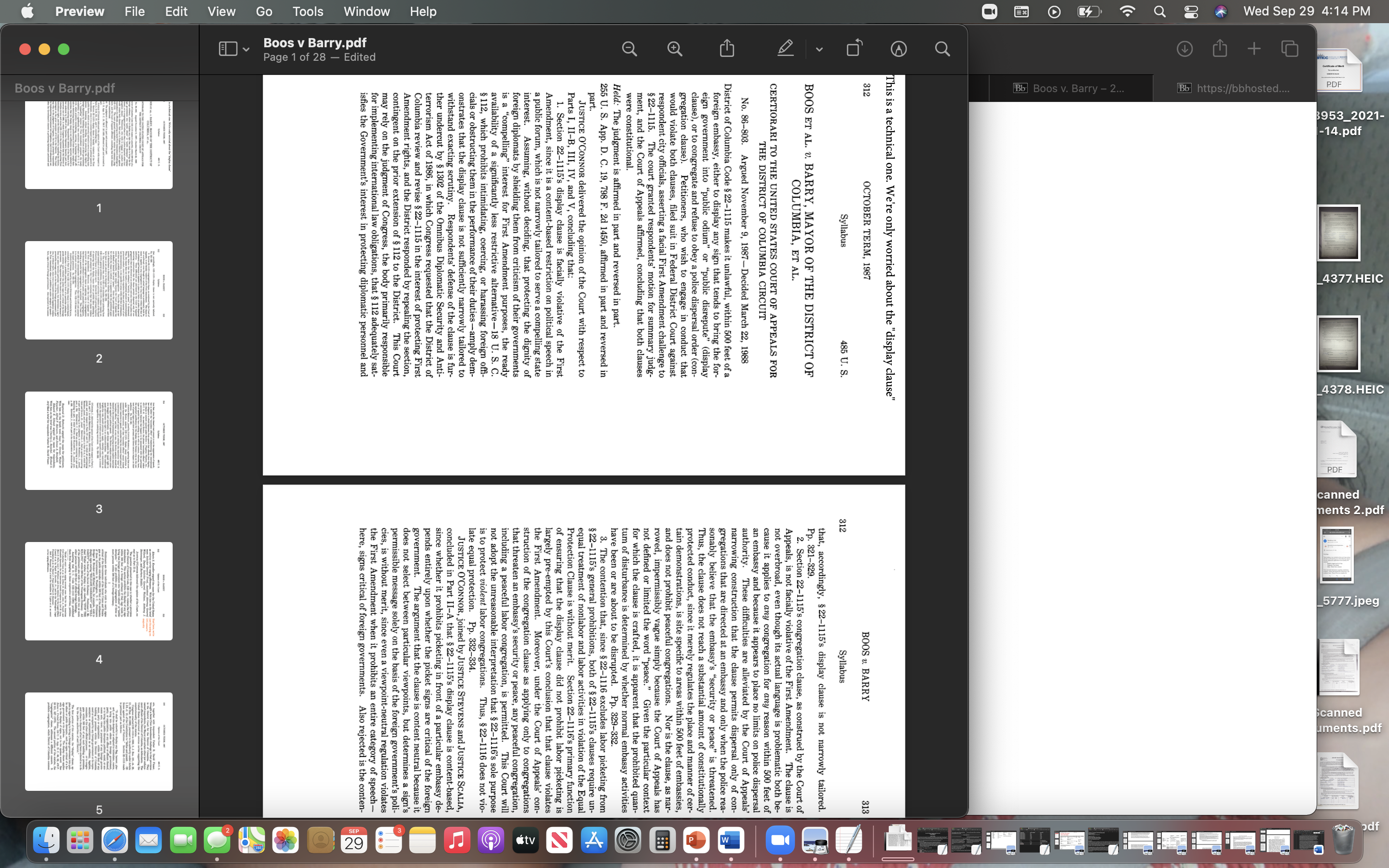
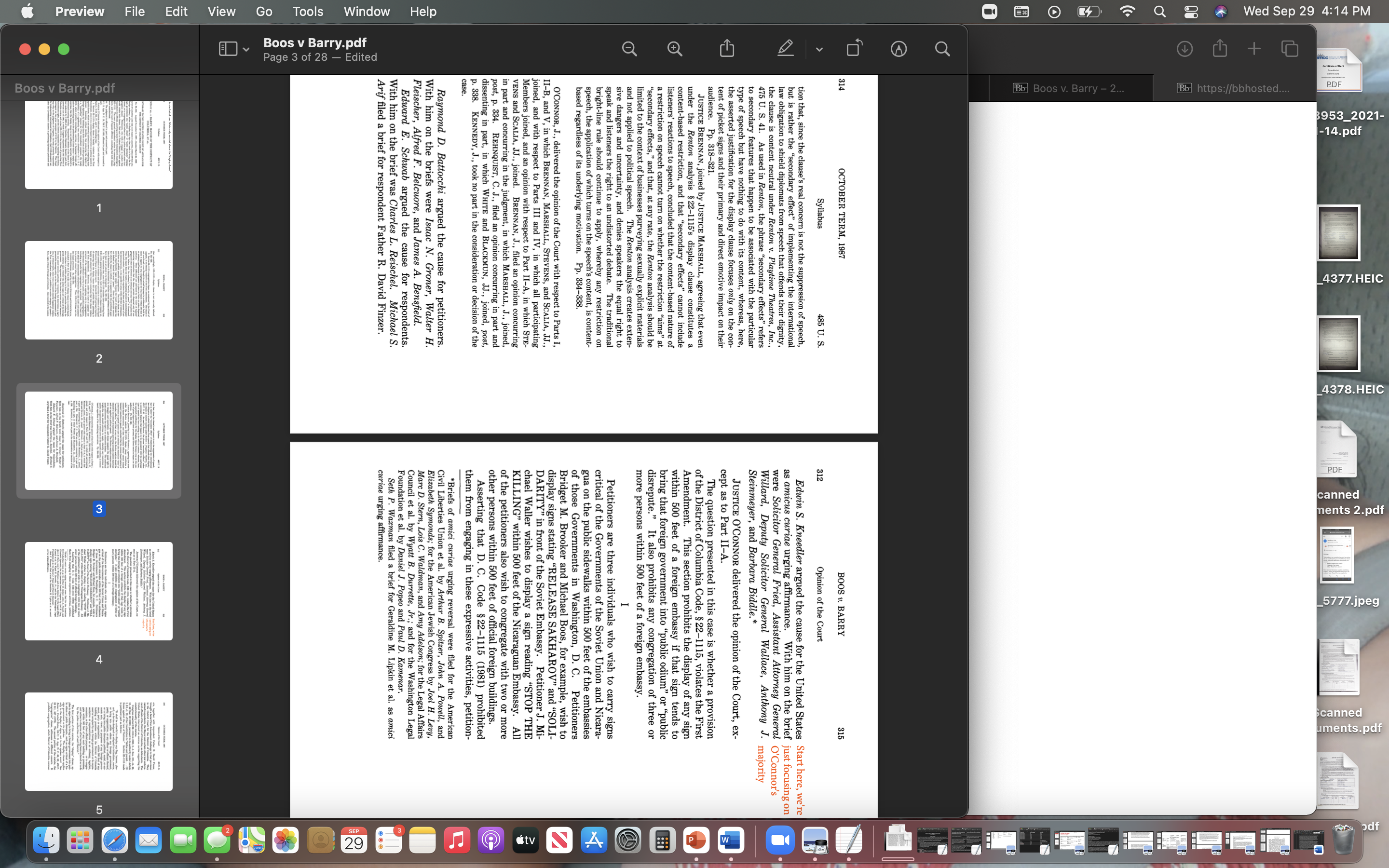
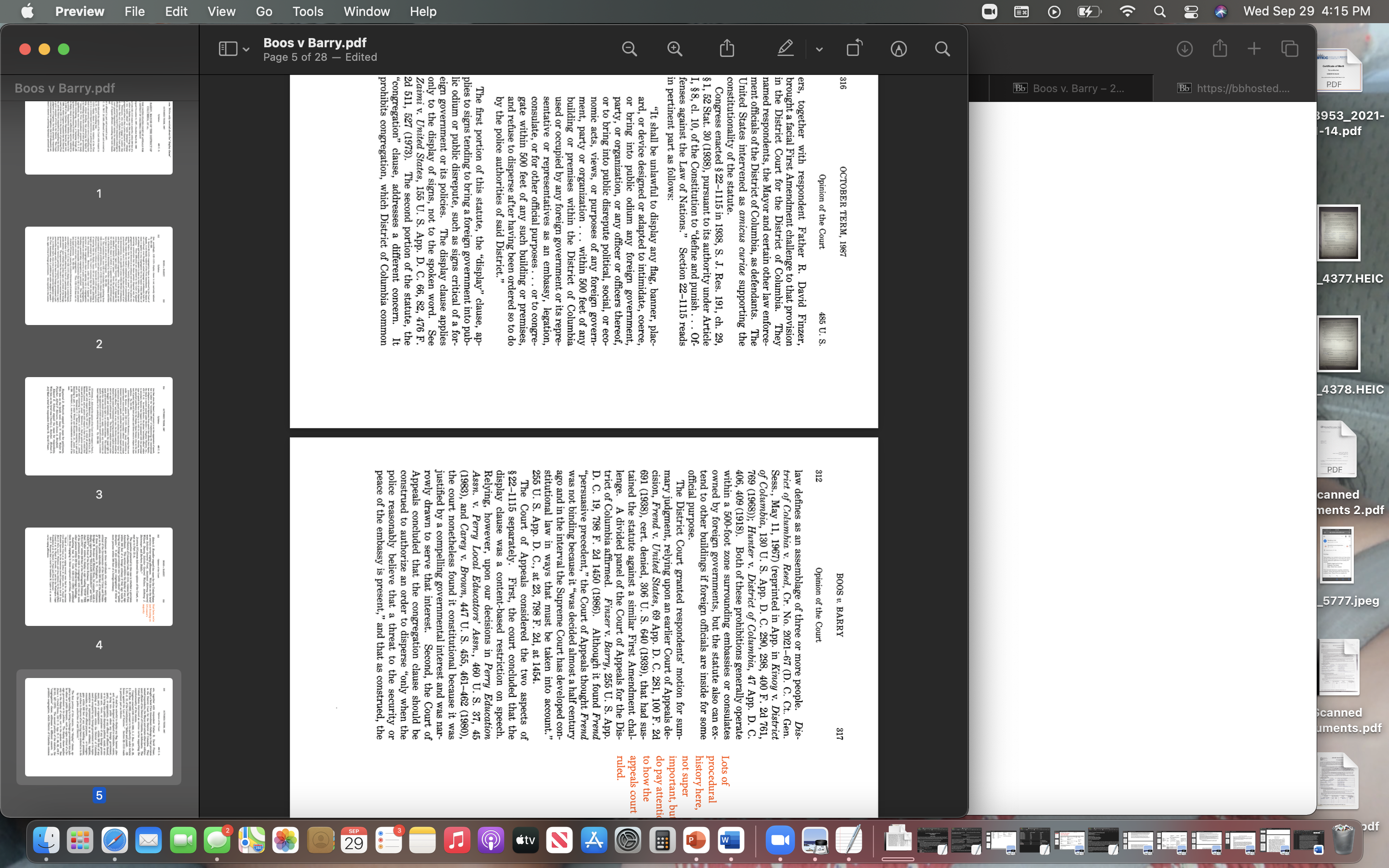
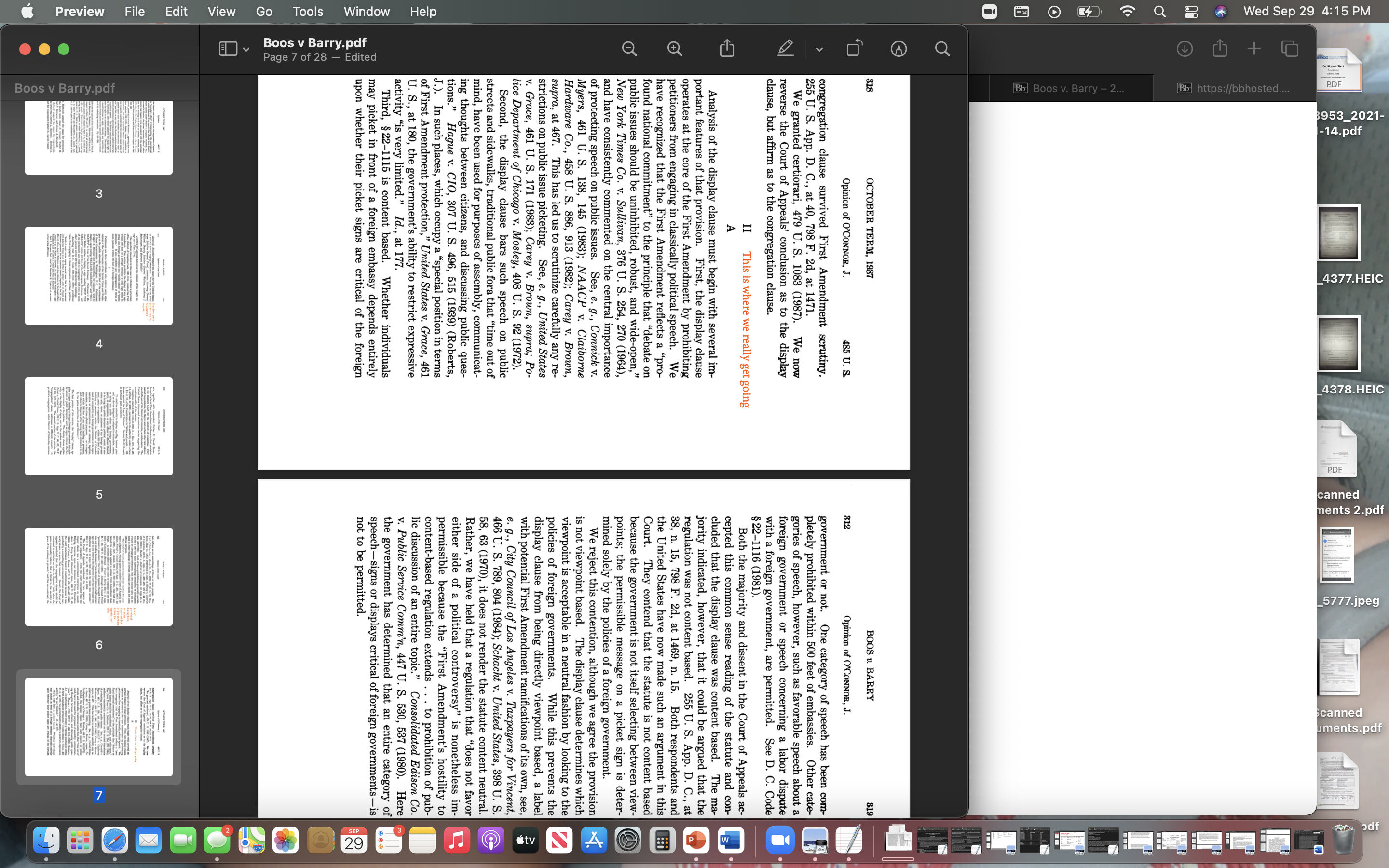
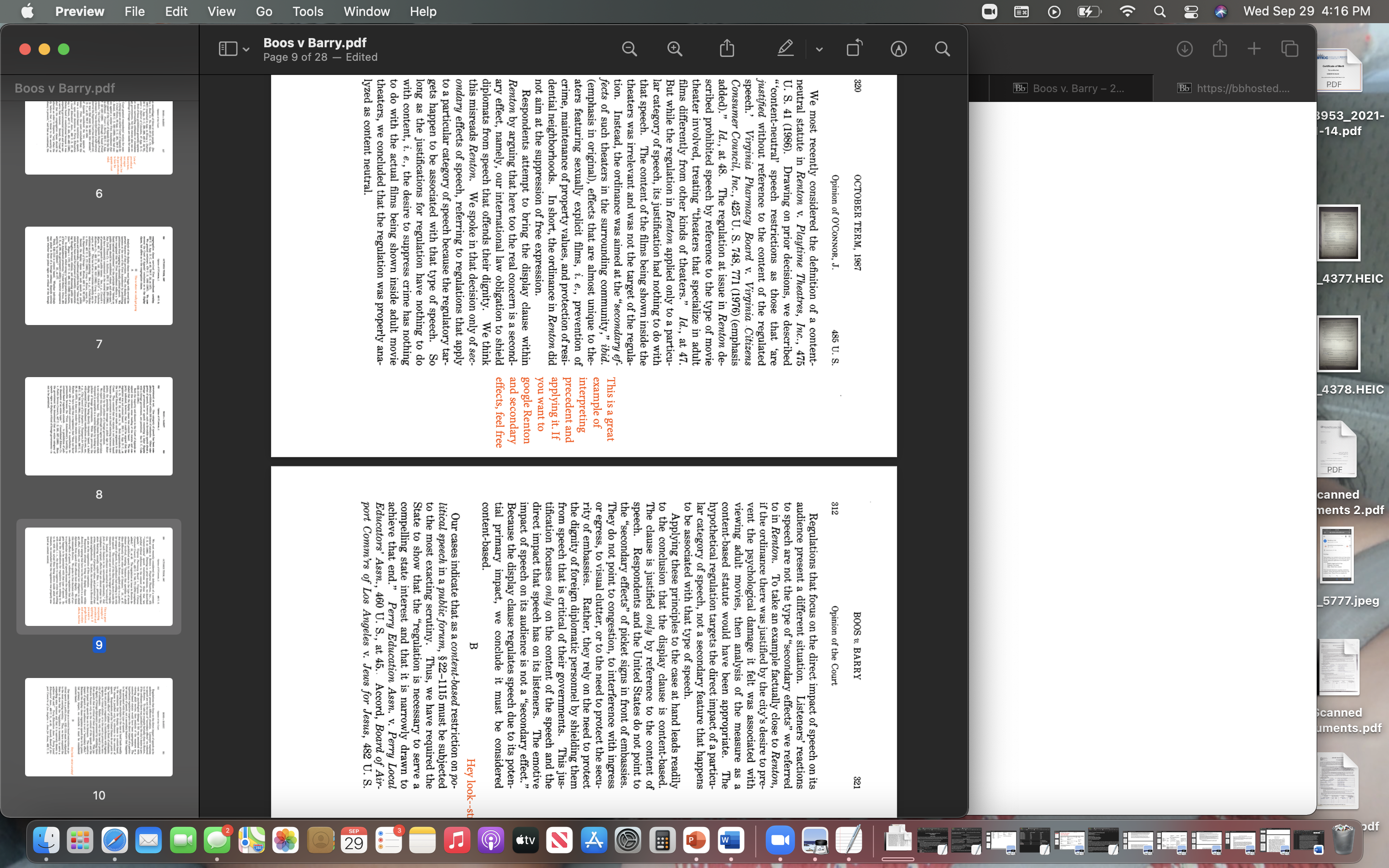

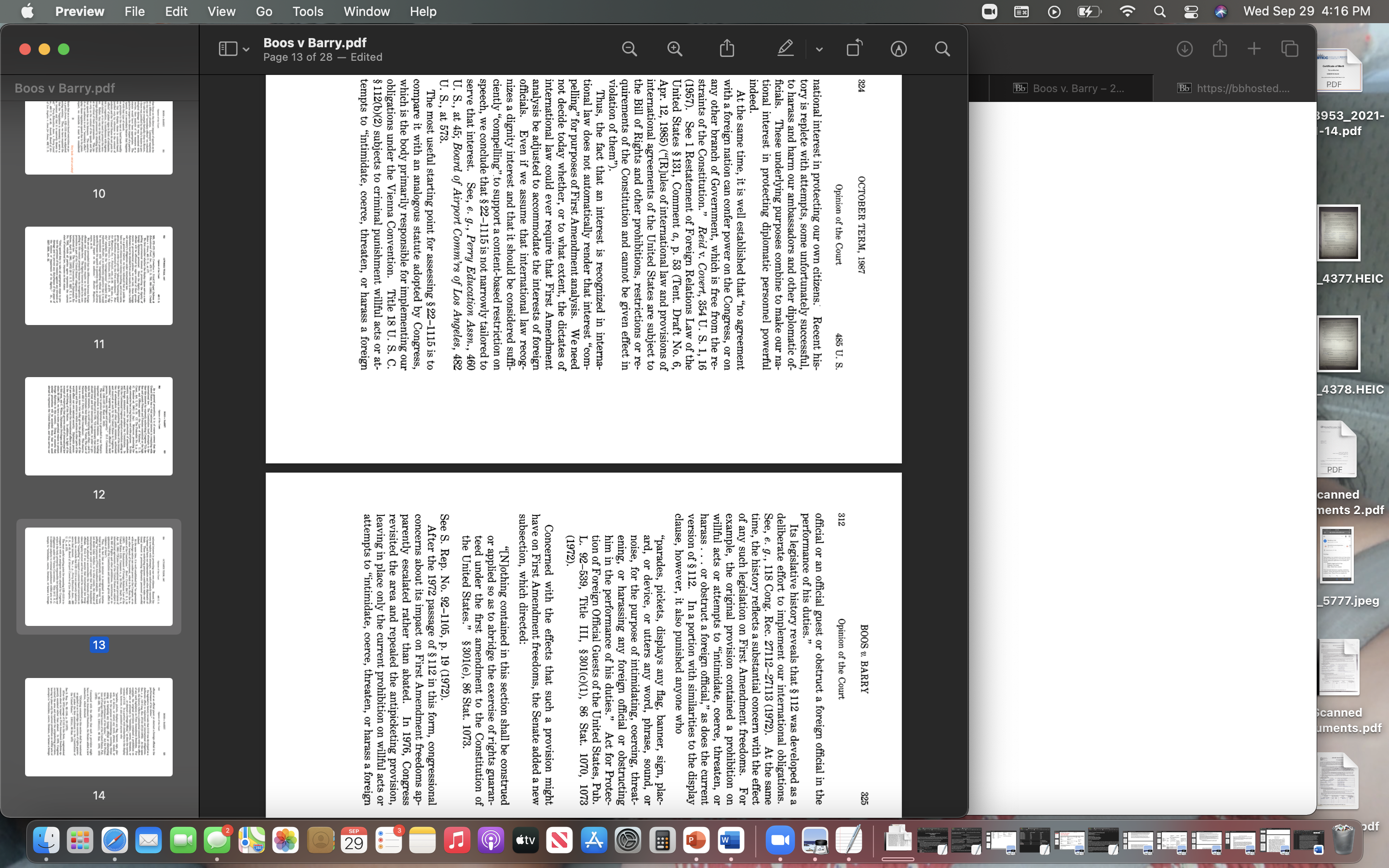
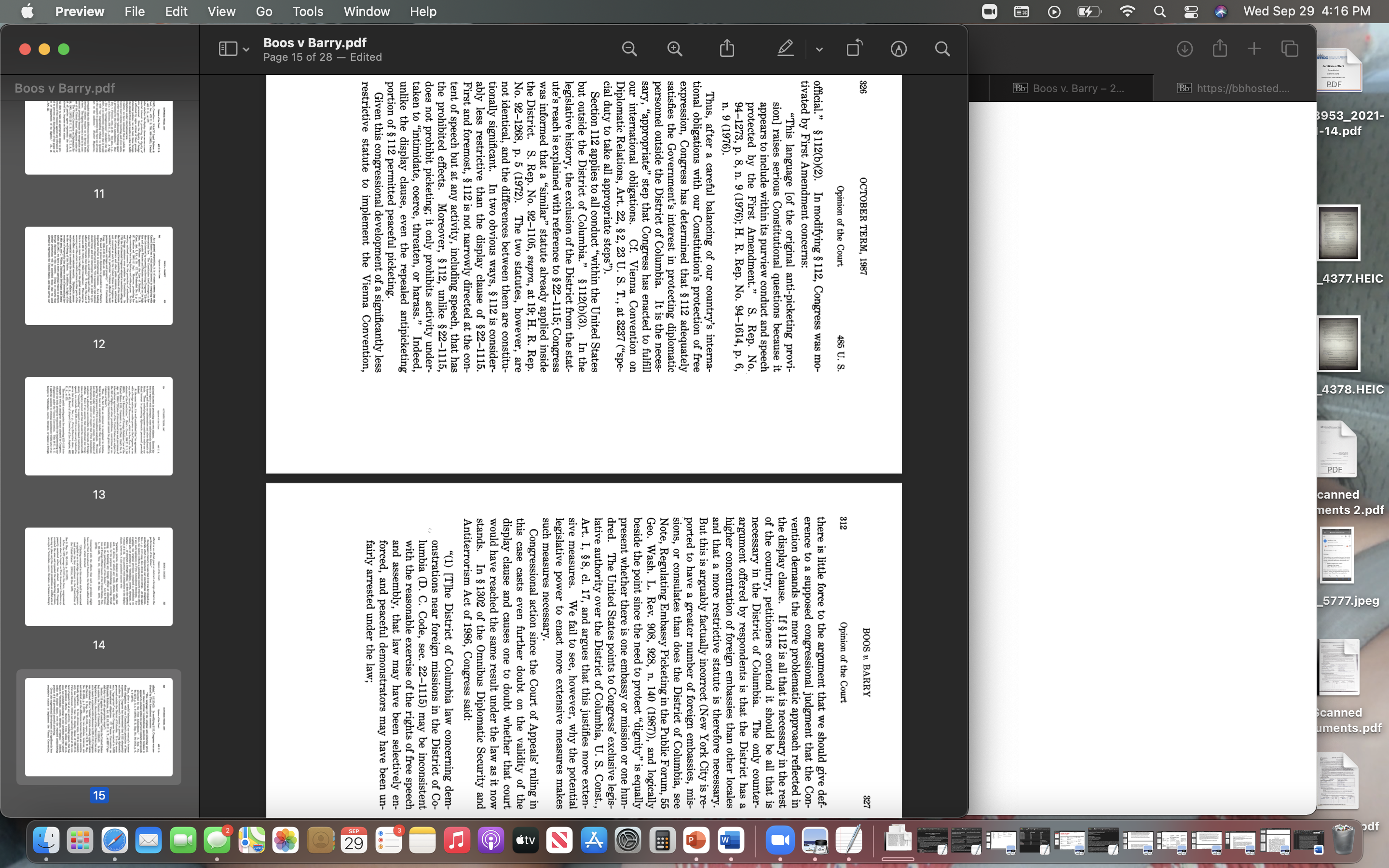
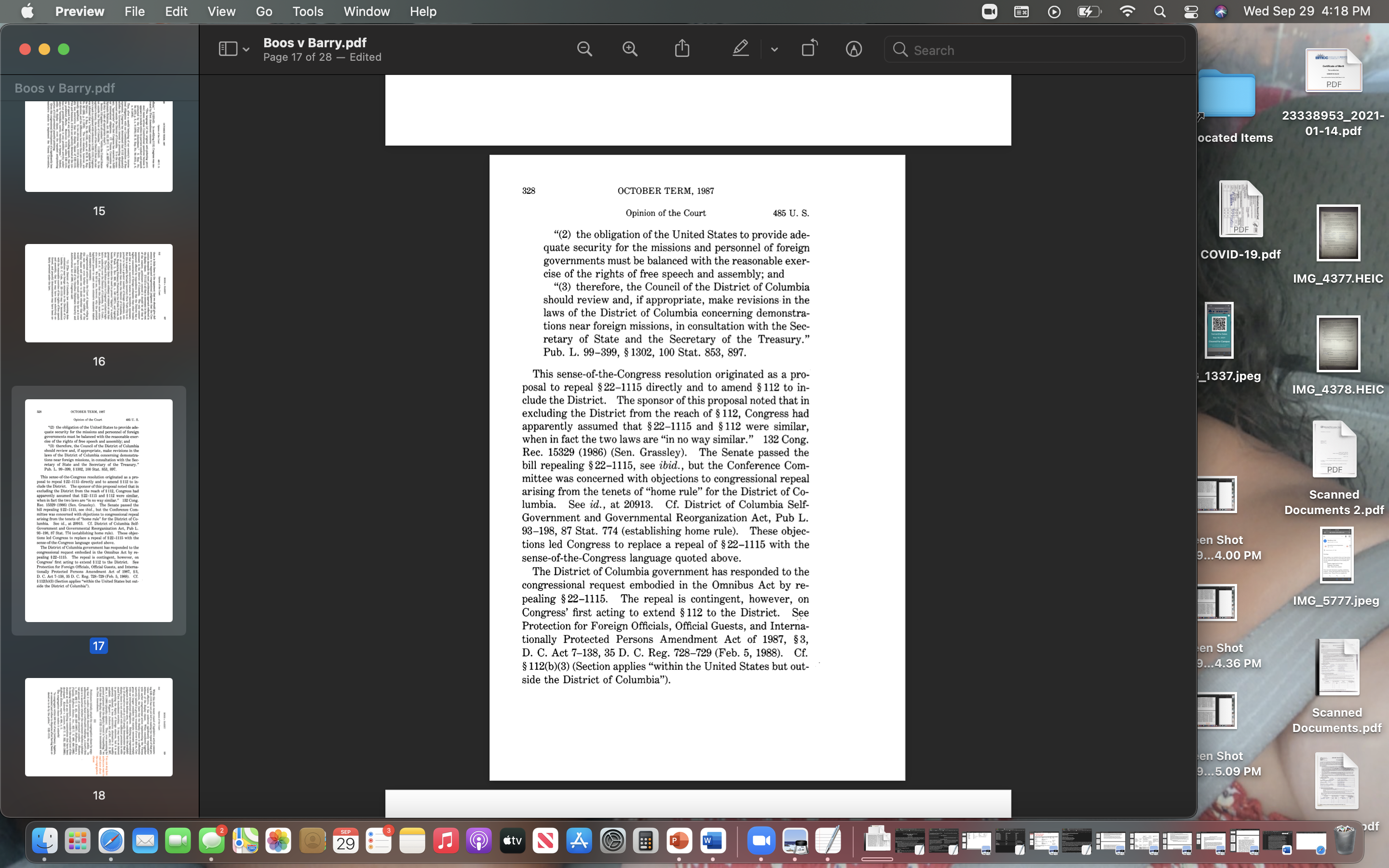
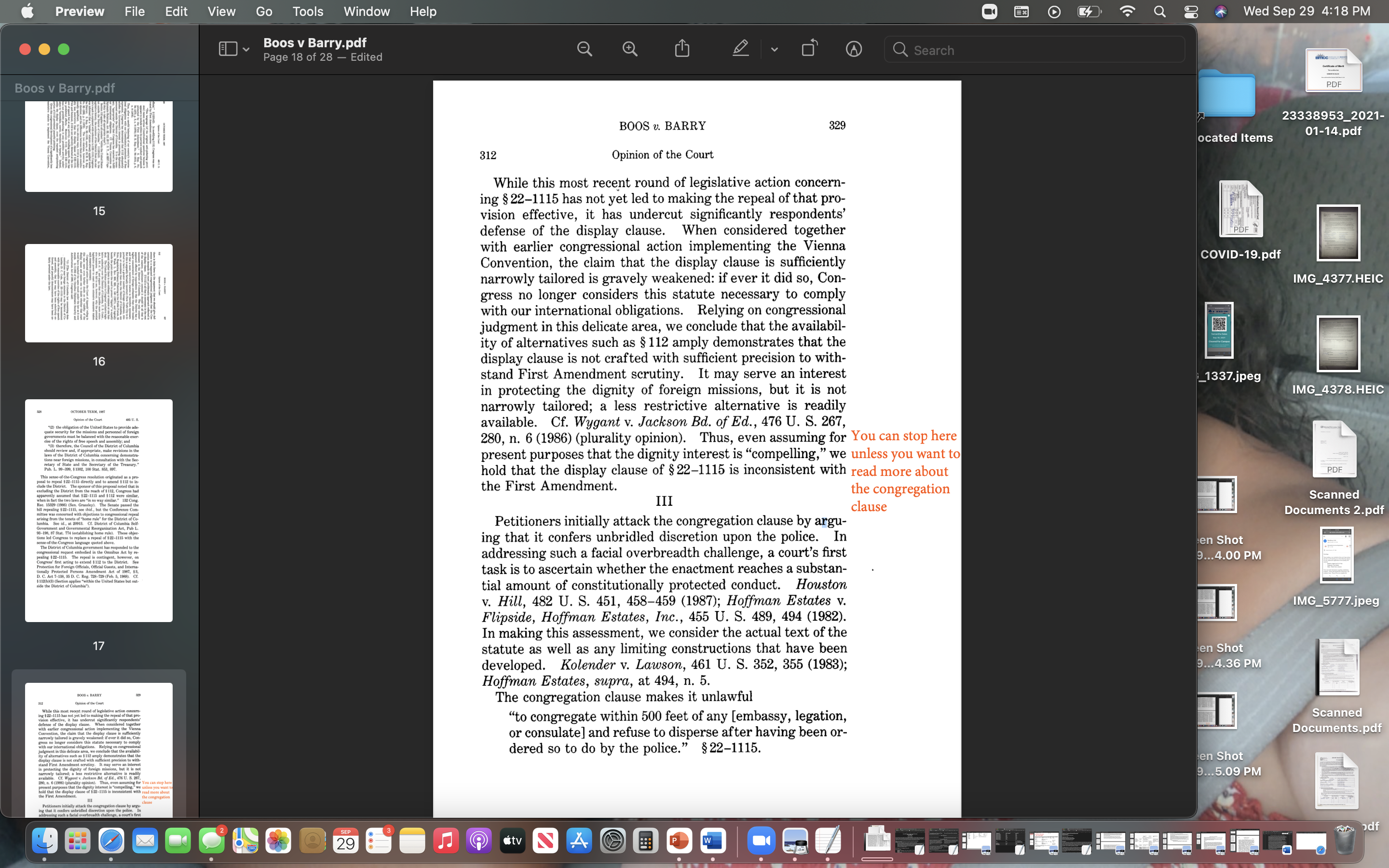
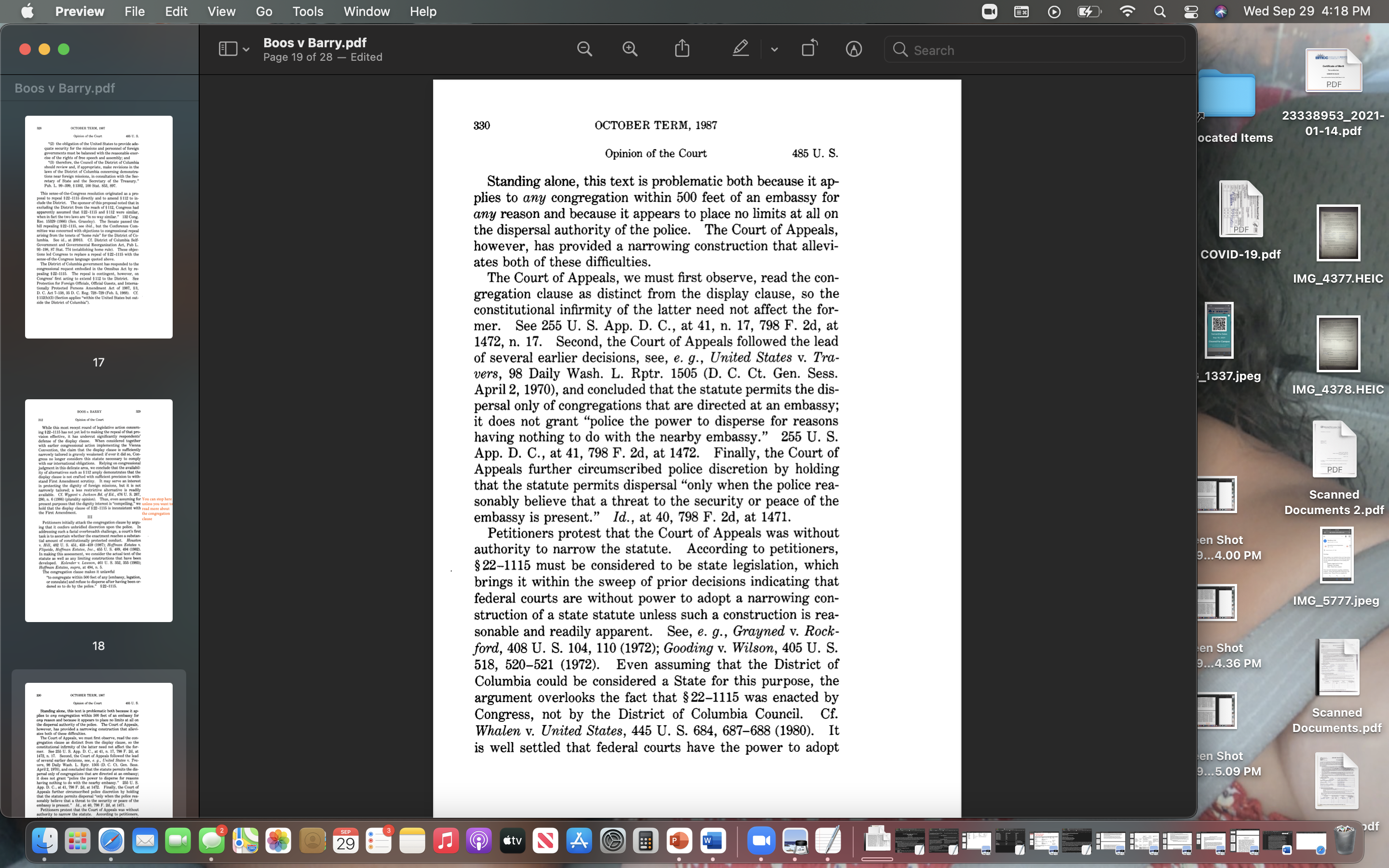
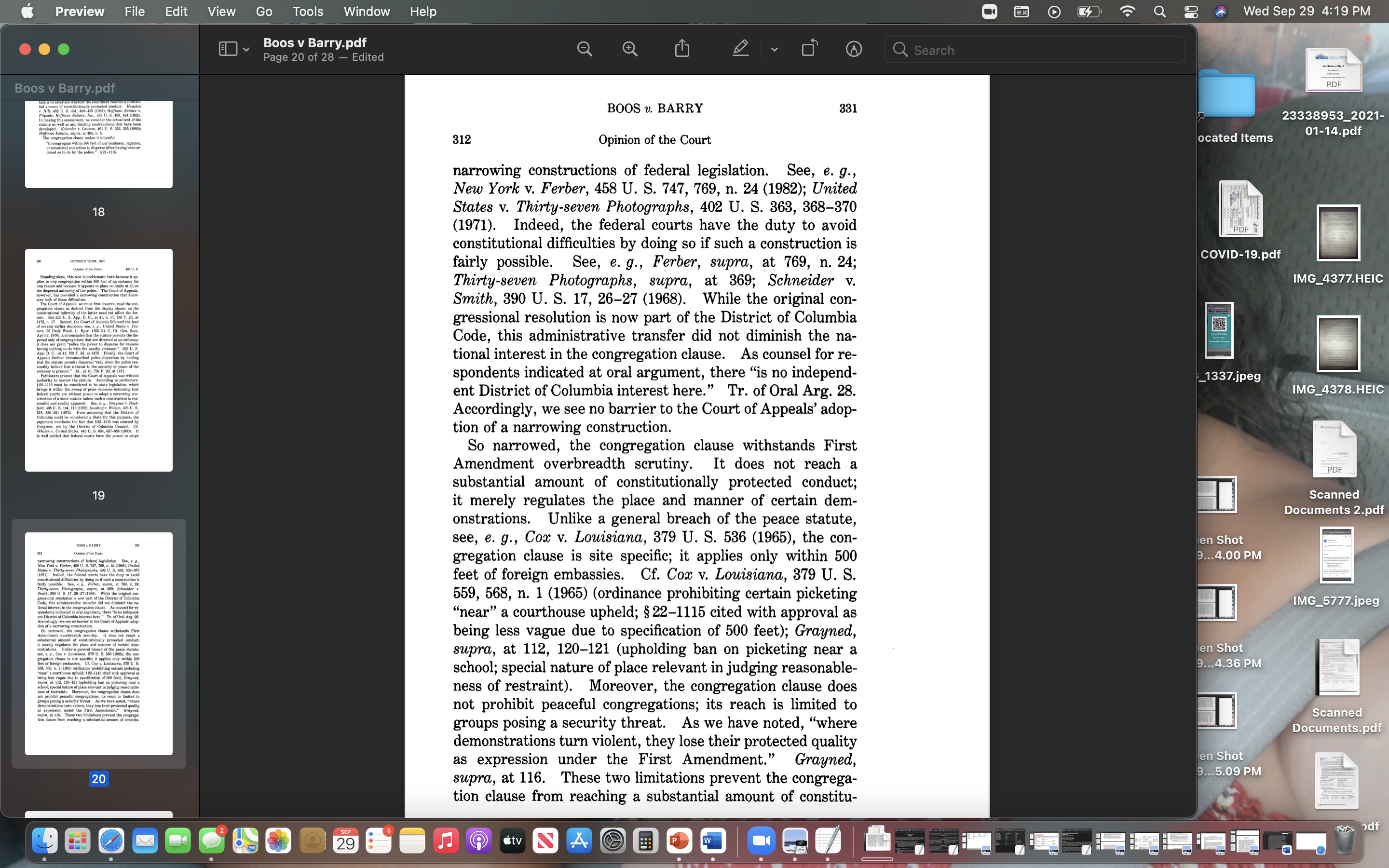
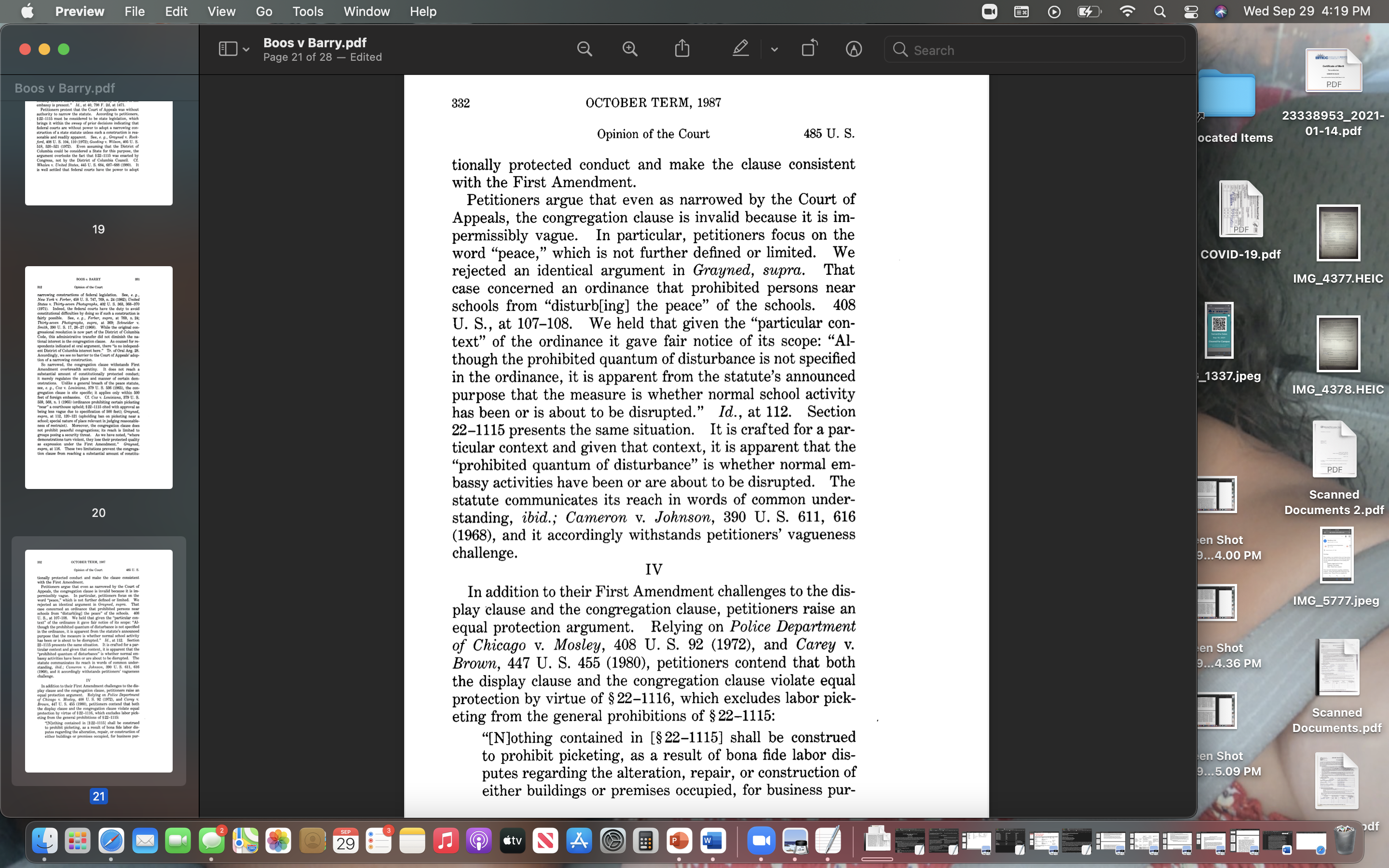
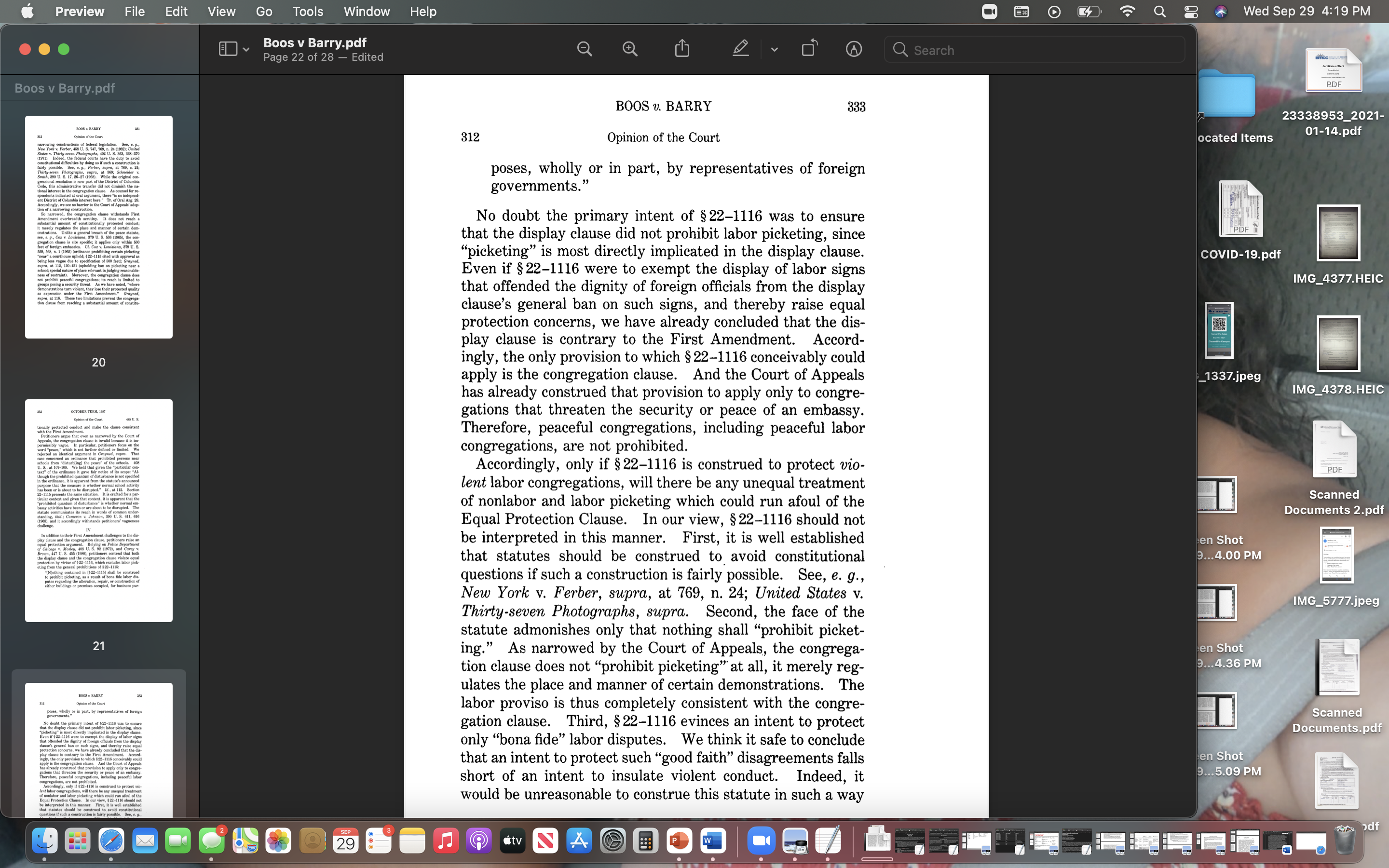
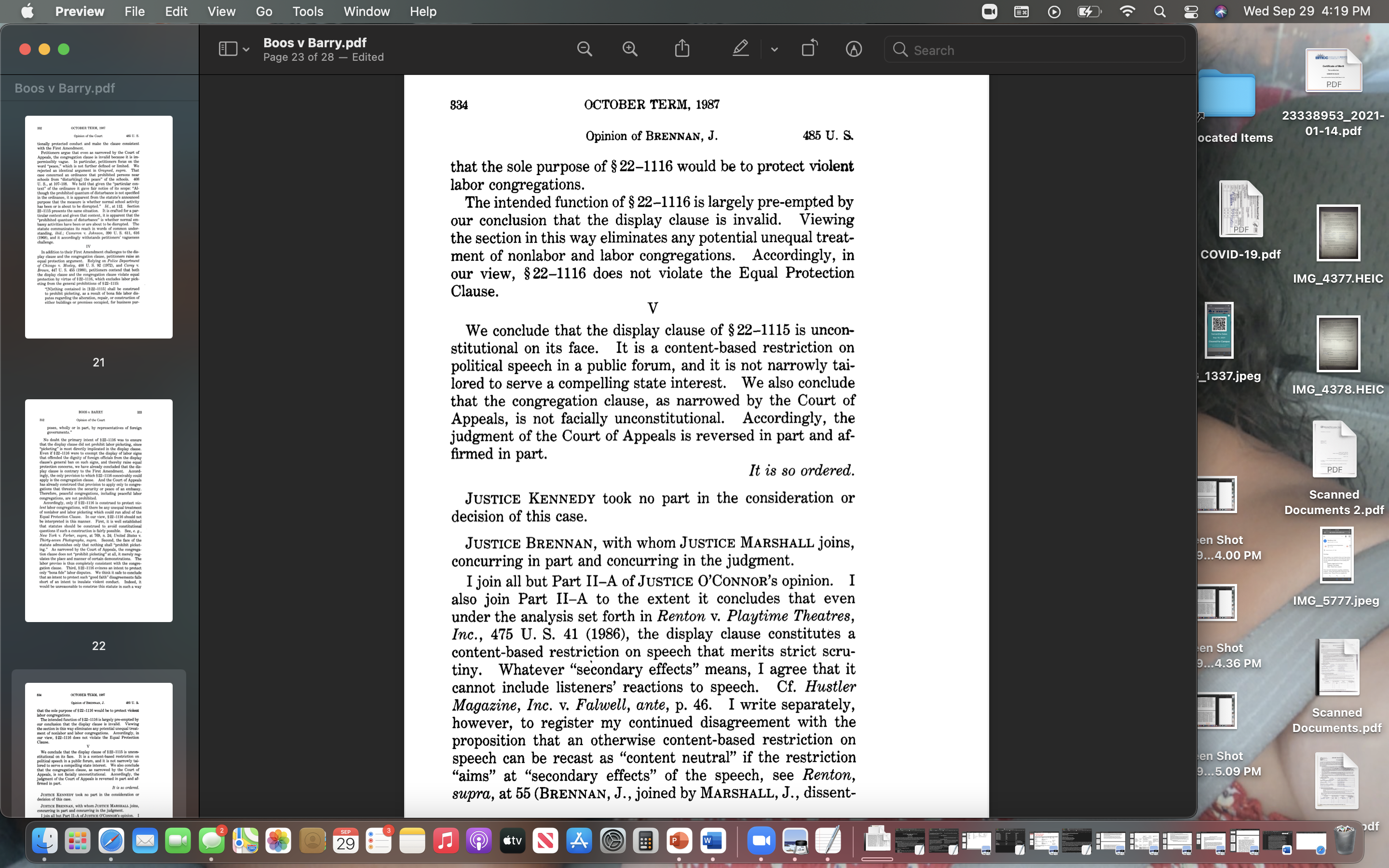


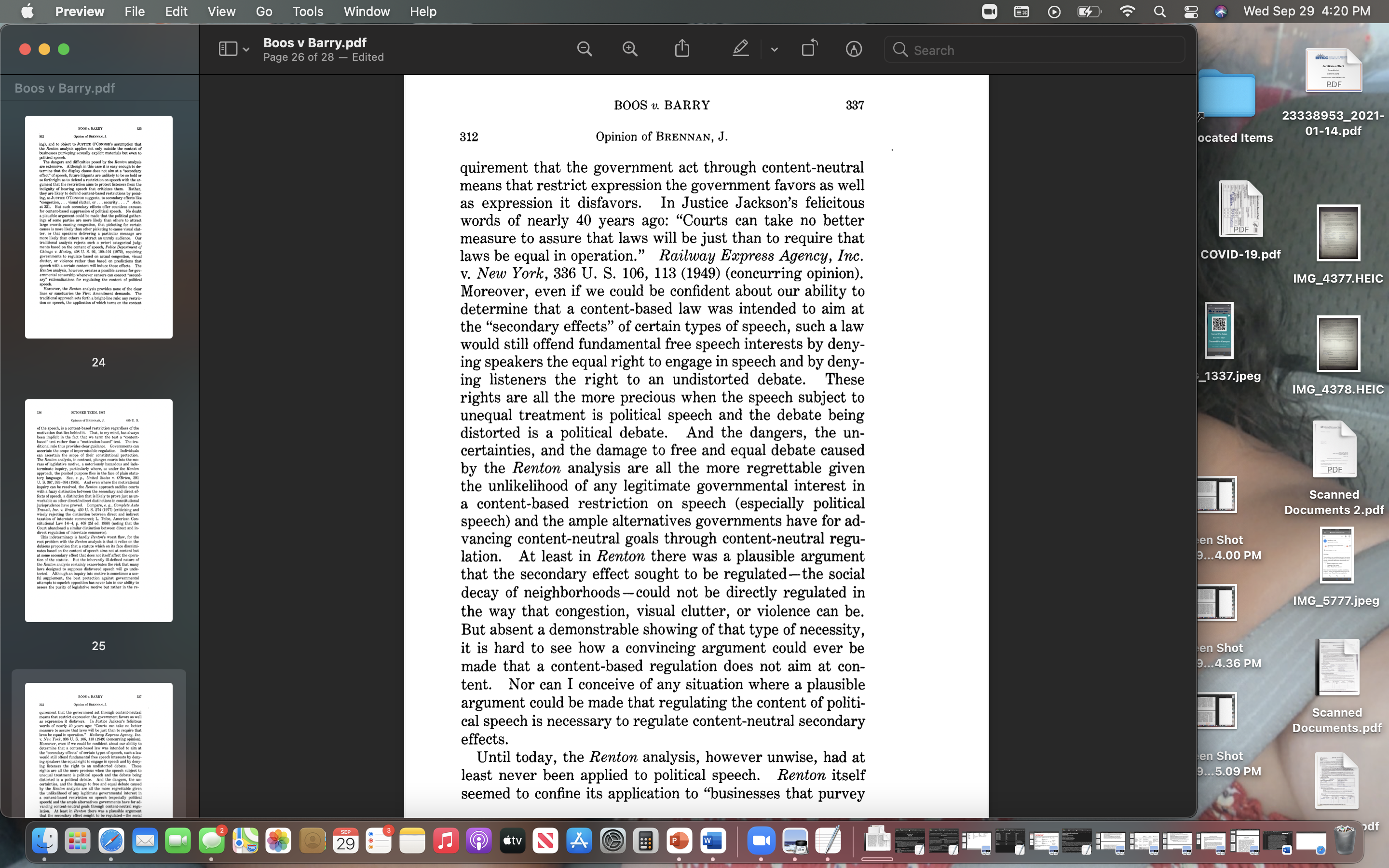
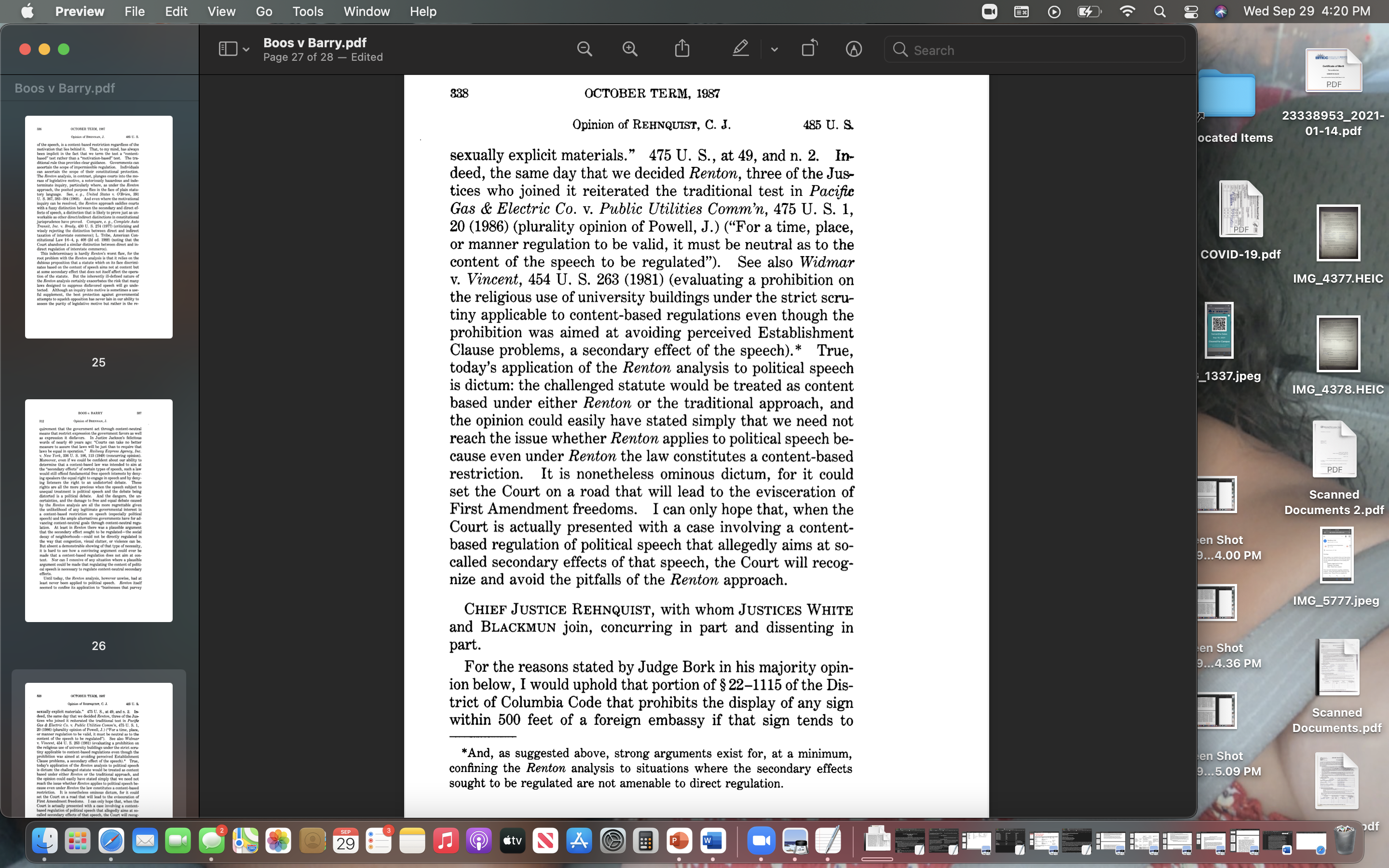
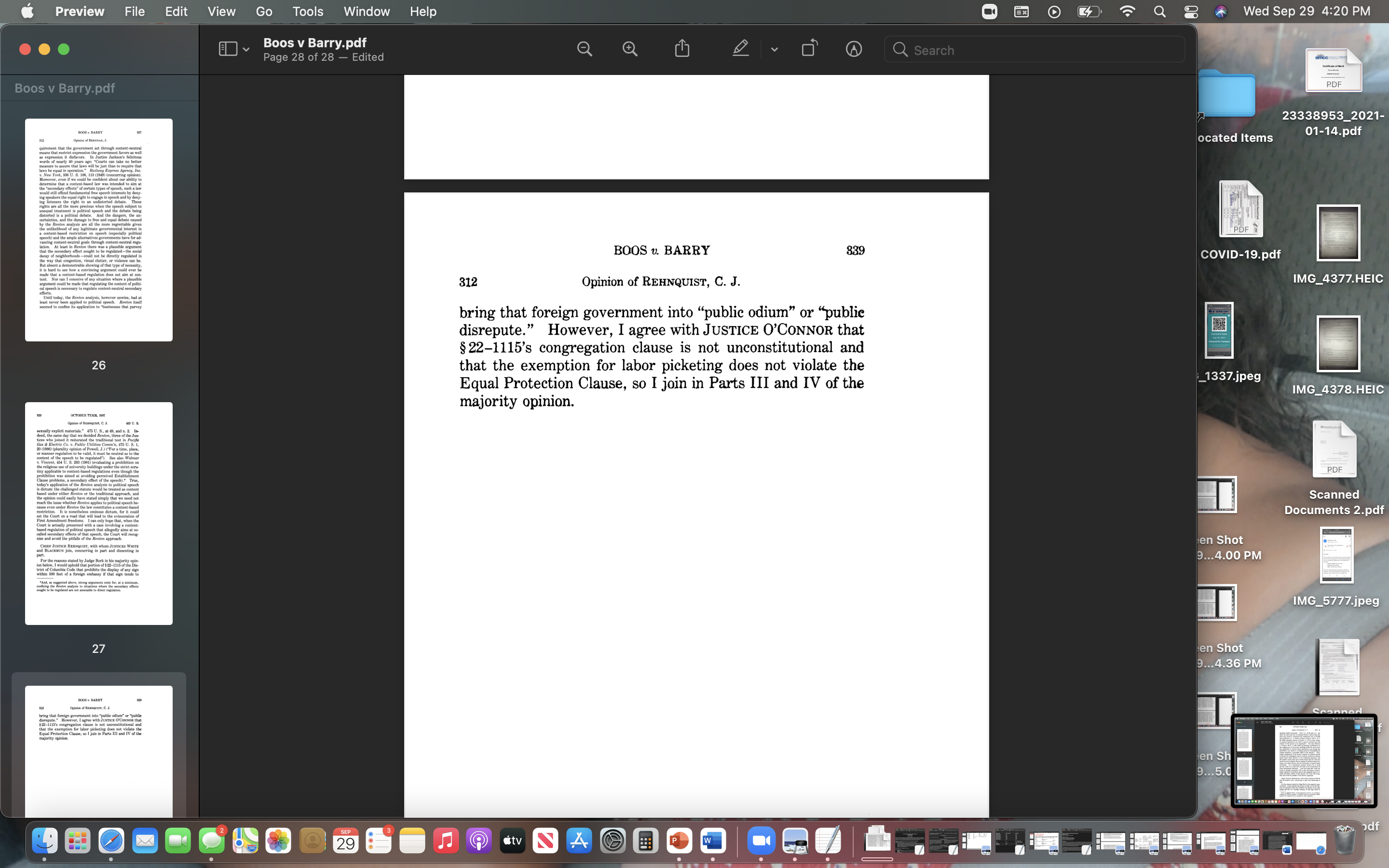 Jpc ments 2.pdf ments.pdf 4377.HEIC 953_2021- 4378.HEIC _5777.jpeg -14.pdf ine- canned canned PDF PDF Q 8 Wed Sep 29 4:14 PM + Bb https://bbhosted.. Bb Boos v. Barry - 2.. O O This is a technical one. We're only worried about the "display clause" 312 OCTOBER TERM, 1987 BOOS v. BARRY 313 Syllabus 485 U. S. 312 Syllabus that, accordingly, $22-1115's display clause is not narrowly tailored. BOOS ET AL. v. BARRY, MAYOR OF THE DISTRICT OF Pp. 321-329. COLUMBIA, ET AL. 2. Section 22-1115's congregation clause, as construed by the Court of Appeals, is not facially violative of the First Amendment. The clause is CERTIORARI TO THE UNITED STATES COURT OF APPEALS FOR not overbroad, even though its actual language is problematic both be- THE DISTRICT OF COLUMBIA CIRCUIT cause it applies to any congregation for any reason within 500 feet of an embassy and because it appears to place no limits on police dispersal No. 86-803. Argued November 9, 1987-Decided March 22, 1988 authority. These difficulties are alleviated by the Court of Appeals' District of Columbia Code $ 22-1115 makes it unlawful, within 500 feet of a narrowing construction that the clause permits dispersal only of con- foreign embassy, either to display any sign that tends to bring the for- gregations that are directed at an embassy and only when the police rea- atened. sign government into "public odium" or "public disrepute" (display sonably believe that the embassy's clause), or to congregate and refuse to obey a police dispersal order (con- Thus, the clause does not reach a substantial amount of constitutionally Ca protected conduct, since it merely regulates the place and manner of cer- gregation clause). Petitioners, who wish to engage in conduct that would violate both clauses, filed suit in Federal District Court against tain demonstrations, is site specific to areas within 500 feet of embassies, respondent city officials, asserting a facial First Amendment challenge to and does not prohibit peaceful congregations. Nor is the clause, as nar- $ 22-1115. The court granted respondents' motion for summary judg rowed, impermissibly vague simply because the Court of Appeals has ment, and the Court of Appeals affirmed, concluding that both clauses not defined or limited the word "peace." Given the particular context were constitutional. for which the clause is crafted, it is apparent that the prohibited quan- tum of disturbance is determined by whether normal embassy activities Held: The judgment is affirmed in part and reversed in part. have been or are about to be disrupted. Pp. 329-332. 255 U. S. App. D. C. 19, 798 F. 2d 1450, affirmed in part and reversed in 3. The contention that, since $ 22-1116 excludes labor picketing from part. $22-1115's general prohibitions, both of $ 22-1115's clauses require un- JUSTICE O'CONNOR delivered the opinion of the Court with respect to equal treatment of nonlabor and labor activities in violation of the Equal Parts I, II-B, III, IV, and V, concluding that: Protection Clause is without merit. Section 22-1116's primary function 1. Section 22-1115's display clause is facially violative of the First of ensuring that the display clause did not prohibit labor picketing is Amendment, since it is a content-based restriction on political speech in largely pre-empted by this Court's conclusion that that clause violates a public forum, which is not narrowly tailored to serve a compelling state the First Amendment. Moreover, under the Court of Appeals' con- interest. Assuming, without deciding, that protecting the dignity of struction of the congregation clause as applying only to congregations foreign diplomats by shielding them from criticism of their governments that threaten an embassy's security or peace, any peaceful congregation, s a "compelling" interest for First Amendment purposes, the ready including a peaceful labor congregation, is permitted. This Court will availability of a significantly less restrictive alternative-18 U. S. C. not adopt the unreasonable interpretation that $ 22-1116's sole purpose $ 112, which prohib assing foreign offi-
Jpc ments 2.pdf ments.pdf 4377.HEIC 953_2021- 4378.HEIC _5777.jpeg -14.pdf ine- canned canned PDF PDF Q 8 Wed Sep 29 4:14 PM + Bb https://bbhosted.. Bb Boos v. Barry - 2.. O O This is a technical one. We're only worried about the "display clause" 312 OCTOBER TERM, 1987 BOOS v. BARRY 313 Syllabus 485 U. S. 312 Syllabus that, accordingly, $22-1115's display clause is not narrowly tailored. BOOS ET AL. v. BARRY, MAYOR OF THE DISTRICT OF Pp. 321-329. COLUMBIA, ET AL. 2. Section 22-1115's congregation clause, as construed by the Court of Appeals, is not facially violative of the First Amendment. The clause is CERTIORARI TO THE UNITED STATES COURT OF APPEALS FOR not overbroad, even though its actual language is problematic both be- THE DISTRICT OF COLUMBIA CIRCUIT cause it applies to any congregation for any reason within 500 feet of an embassy and because it appears to place no limits on police dispersal No. 86-803. Argued November 9, 1987-Decided March 22, 1988 authority. These difficulties are alleviated by the Court of Appeals' District of Columbia Code $ 22-1115 makes it unlawful, within 500 feet of a narrowing construction that the clause permits dispersal only of con- foreign embassy, either to display any sign that tends to bring the for- gregations that are directed at an embassy and only when the police rea- atened. sign government into "public odium" or "public disrepute" (display sonably believe that the embassy's clause), or to congregate and refuse to obey a police dispersal order (con- Thus, the clause does not reach a substantial amount of constitutionally Ca protected conduct, since it merely regulates the place and manner of cer- gregation clause). Petitioners, who wish to engage in conduct that would violate both clauses, filed suit in Federal District Court against tain demonstrations, is site specific to areas within 500 feet of embassies, respondent city officials, asserting a facial First Amendment challenge to and does not prohibit peaceful congregations. Nor is the clause, as nar- $ 22-1115. The court granted respondents' motion for summary judg rowed, impermissibly vague simply because the Court of Appeals has ment, and the Court of Appeals affirmed, concluding that both clauses not defined or limited the word "peace." Given the particular context were constitutional. for which the clause is crafted, it is apparent that the prohibited quan- tum of disturbance is determined by whether normal embassy activities Held: The judgment is affirmed in part and reversed in part. have been or are about to be disrupted. Pp. 329-332. 255 U. S. App. D. C. 19, 798 F. 2d 1450, affirmed in part and reversed in 3. The contention that, since $ 22-1116 excludes labor picketing from part. $22-1115's general prohibitions, both of $ 22-1115's clauses require un- JUSTICE O'CONNOR delivered the opinion of the Court with respect to equal treatment of nonlabor and labor activities in violation of the Equal Parts I, II-B, III, IV, and V, concluding that: Protection Clause is without merit. Section 22-1116's primary function 1. Section 22-1115's display clause is facially violative of the First of ensuring that the display clause did not prohibit labor picketing is Amendment, since it is a content-based restriction on political speech in largely pre-empted by this Court's conclusion that that clause violates a public forum, which is not narrowly tailored to serve a compelling state the First Amendment. Moreover, under the Court of Appeals' con- interest. Assuming, without deciding, that protecting the dignity of struction of the congregation clause as applying only to congregations foreign diplomats by shielding them from criticism of their governments that threaten an embassy's security or peace, any peaceful congregation, s a "compelling" interest for First Amendment purposes, the ready including a peaceful labor congregation, is permitted. This Court will availability of a significantly less restrictive alternative-18 U. S. C. not adopt the unreasonable interpretation that $ 22-1116's sole purpose $ 112, which prohib assing foreign offi- Step by Step Solution
There are 3 Steps involved in it
Step: 1

Get Instant Access to Expert-Tailored Solutions
See step-by-step solutions with expert insights and AI powered tools for academic success
Step: 2

Step: 3

Ace Your Homework with AI
Get the answers you need in no time with our AI-driven, step-by-step assistance
Get Started


